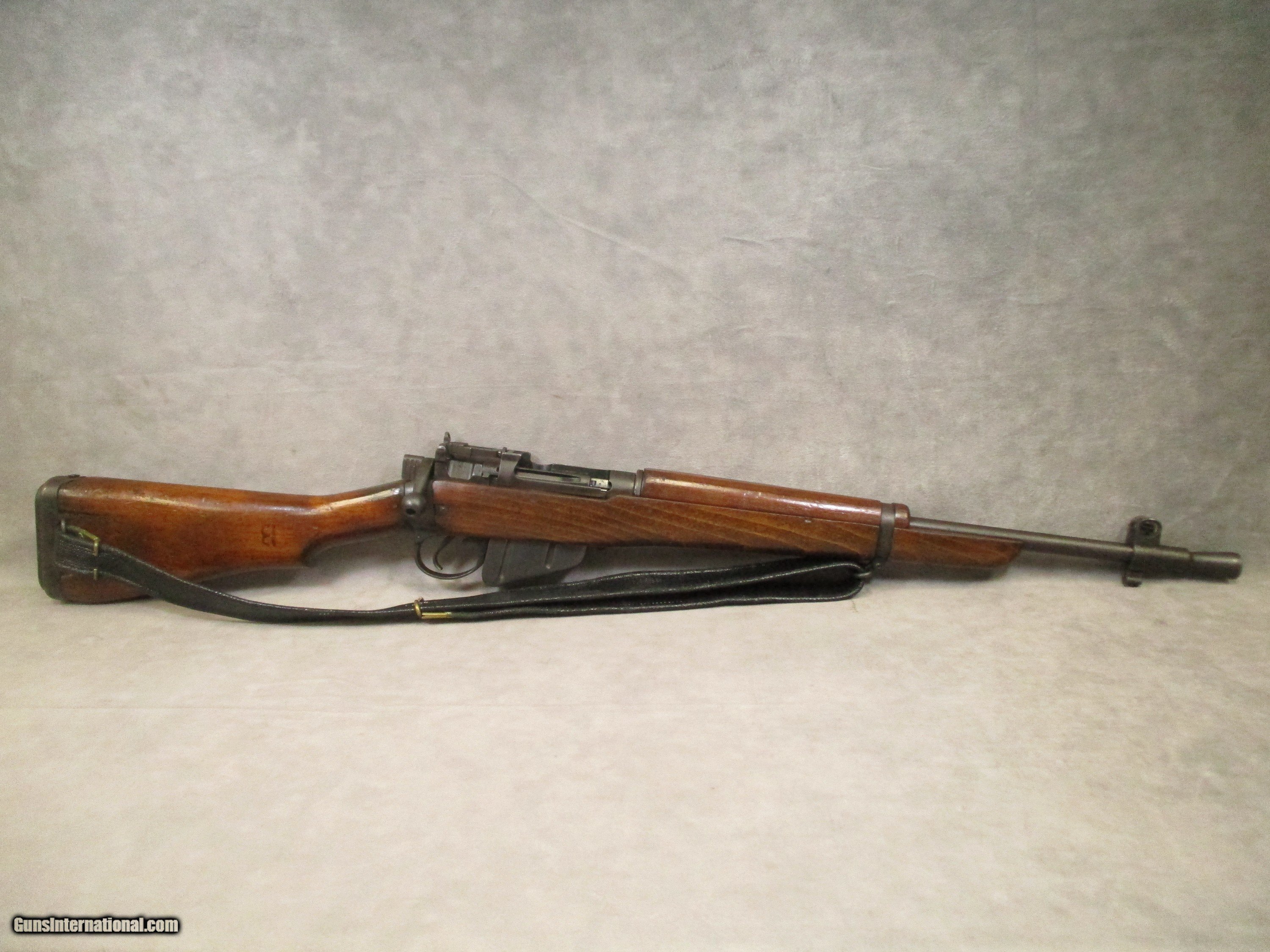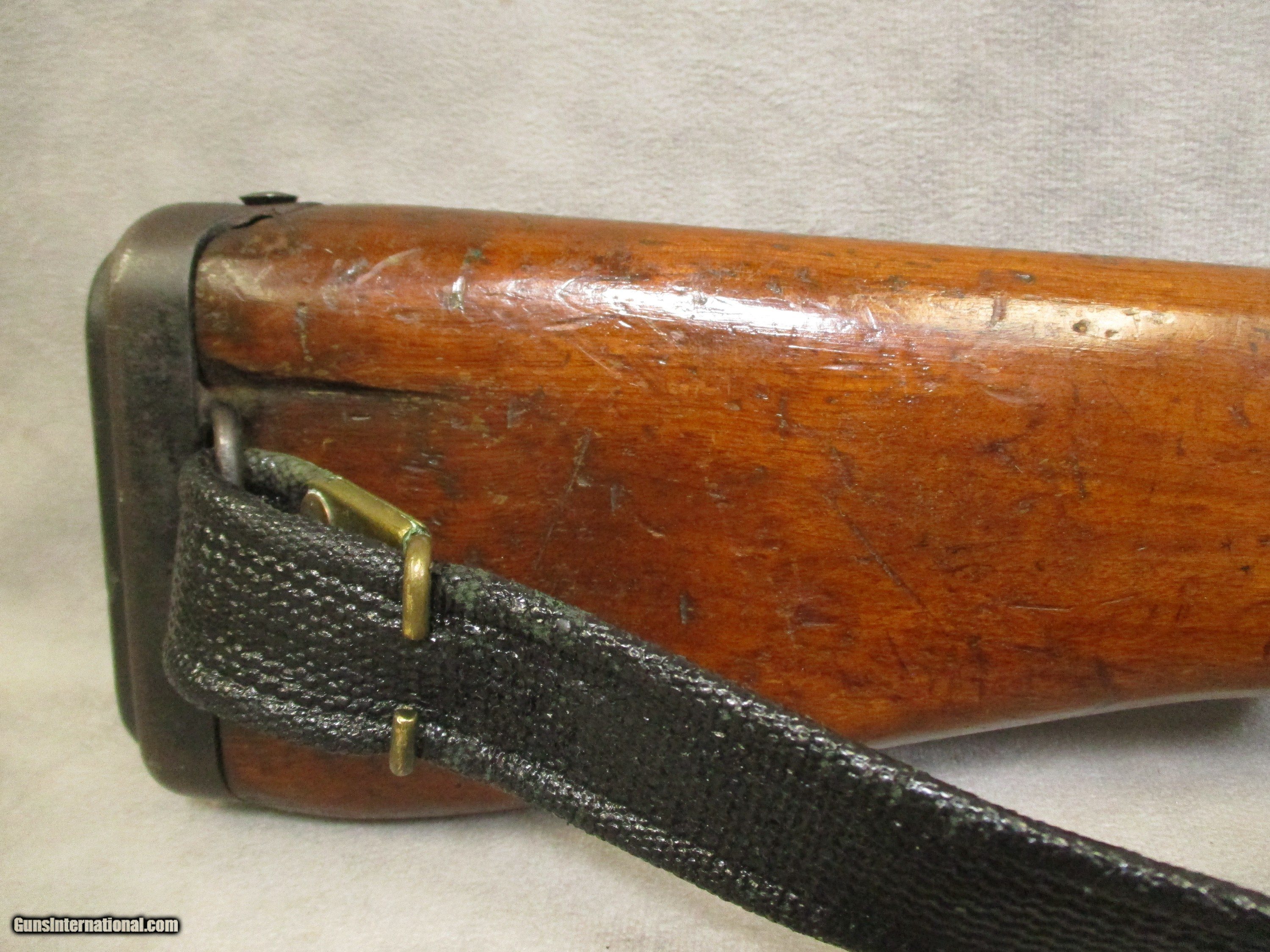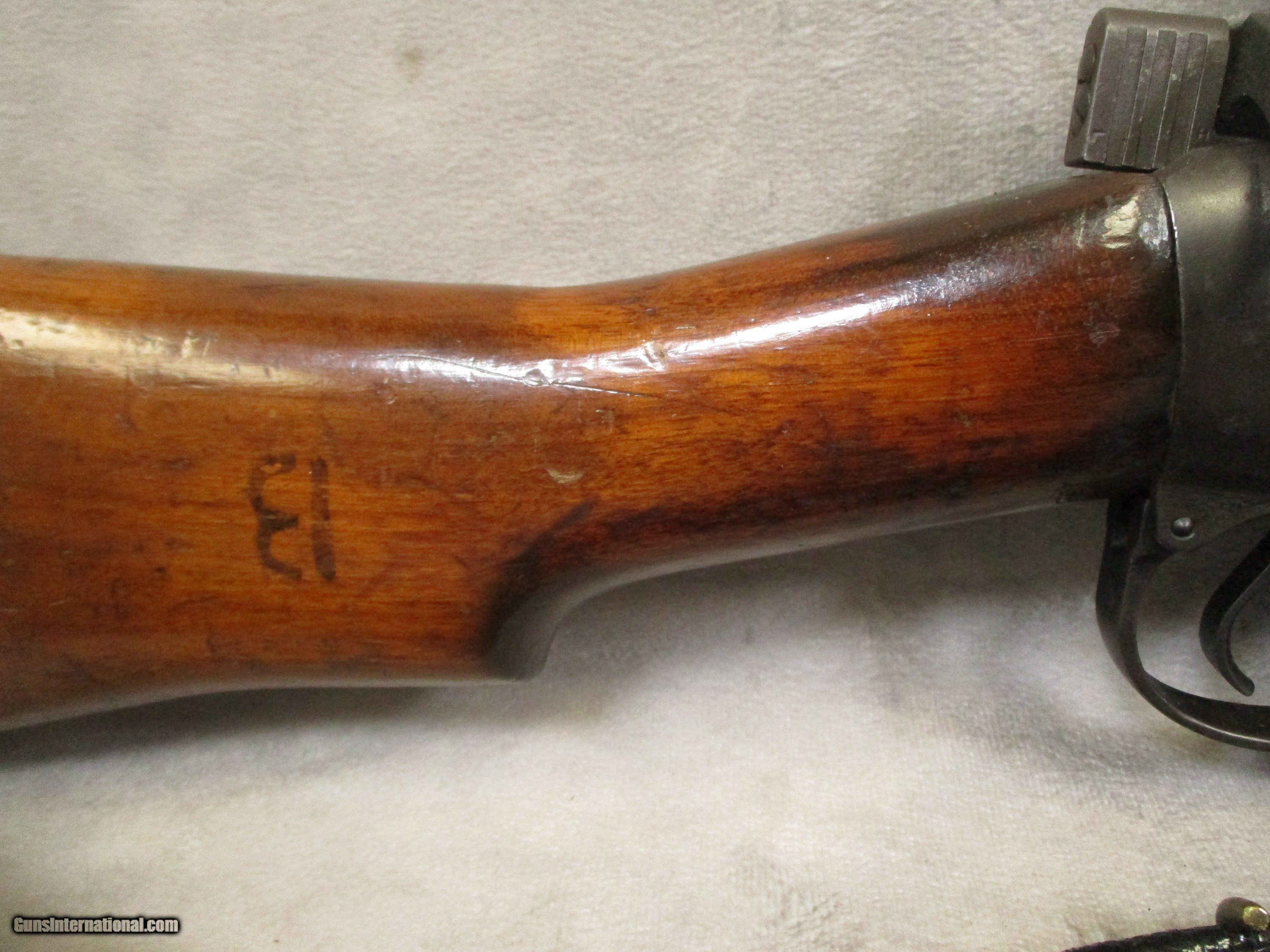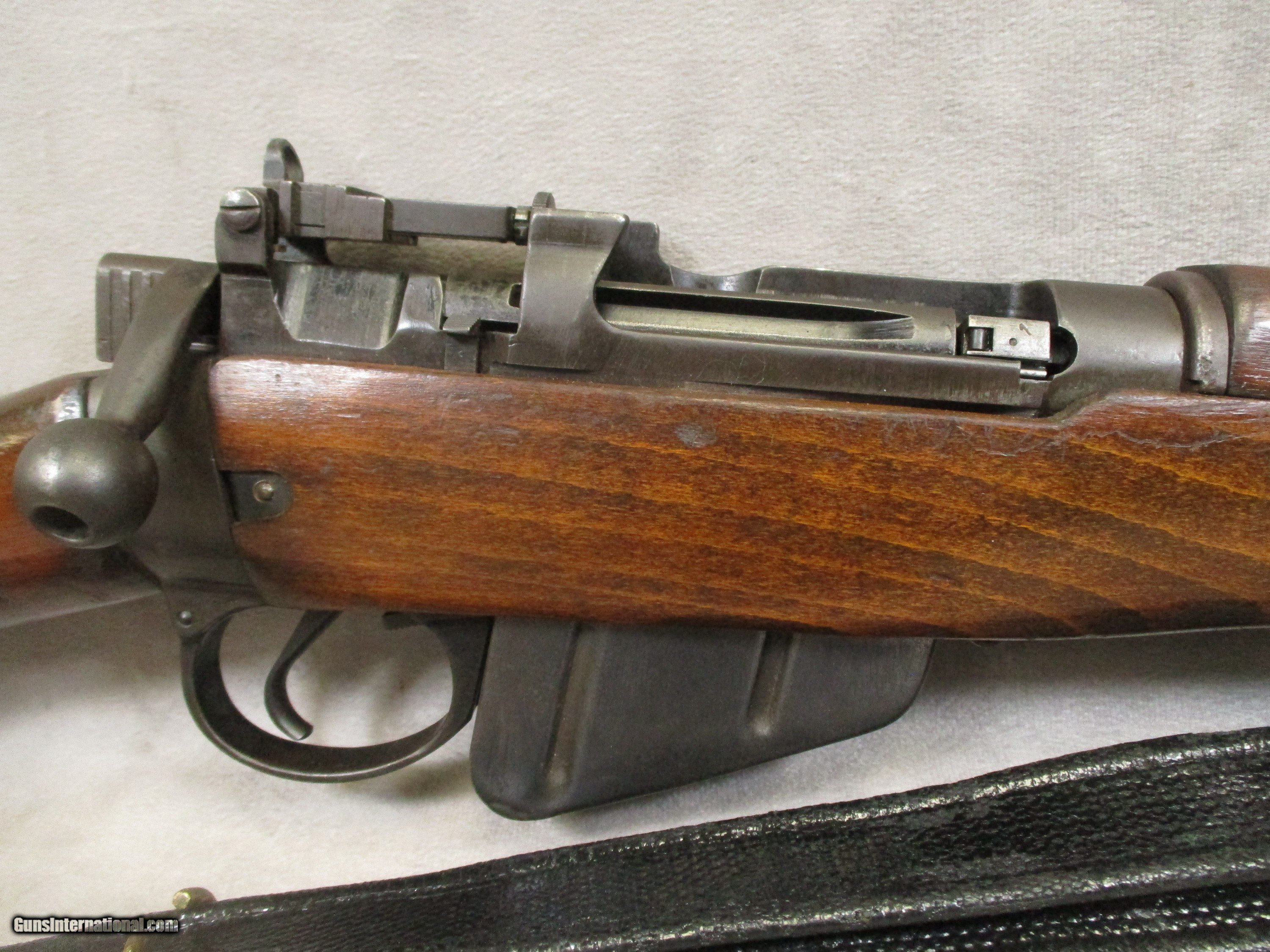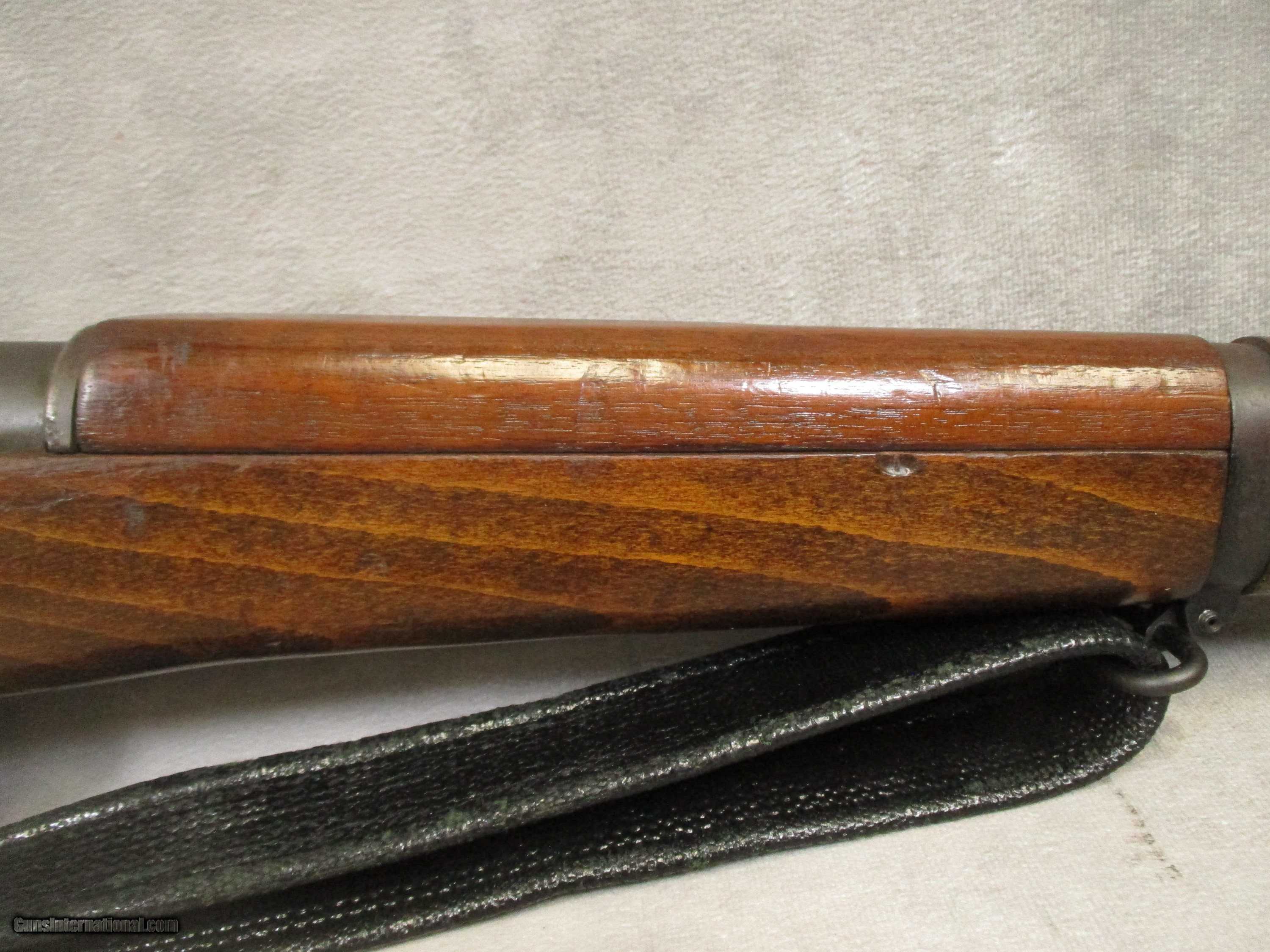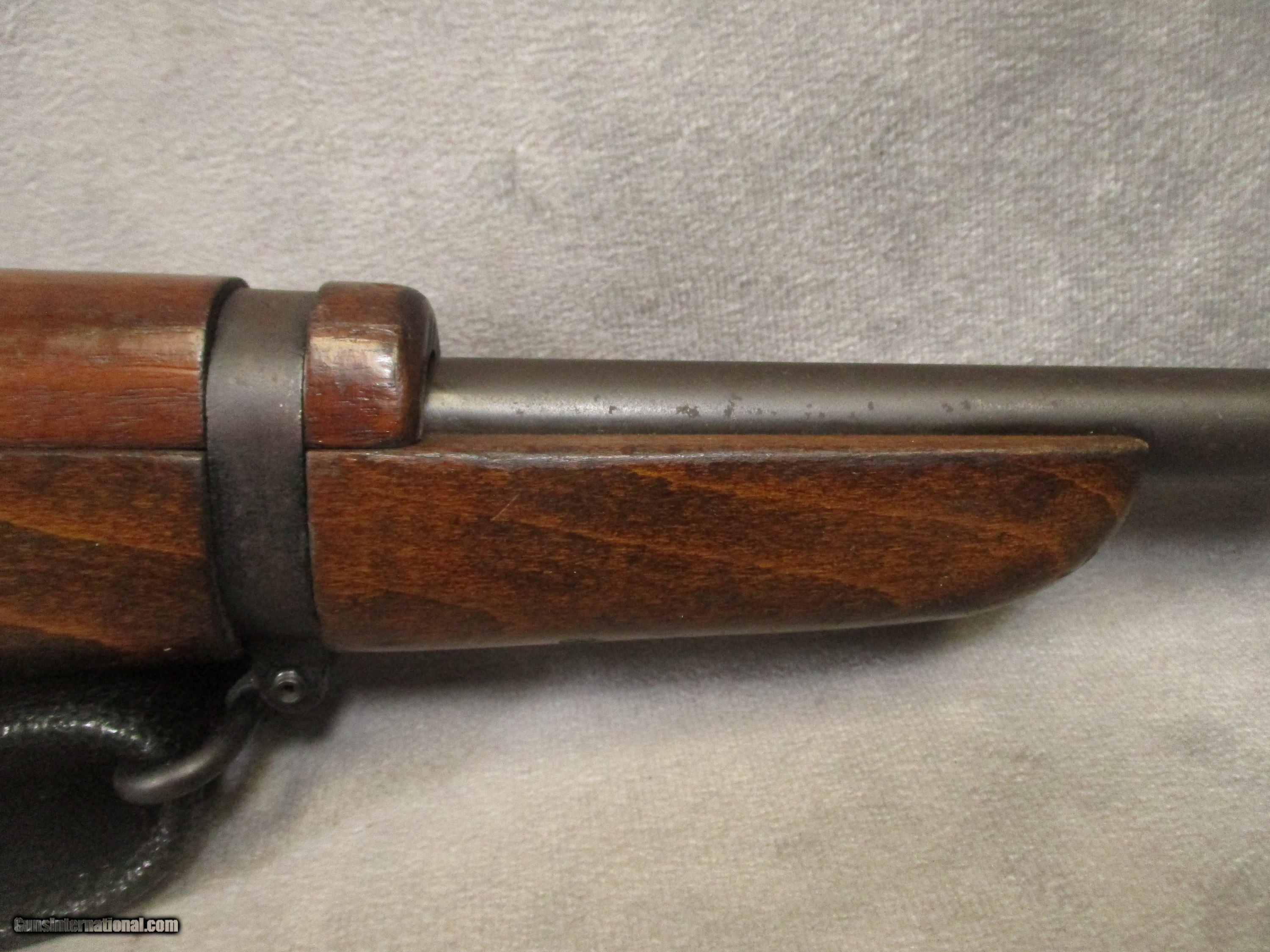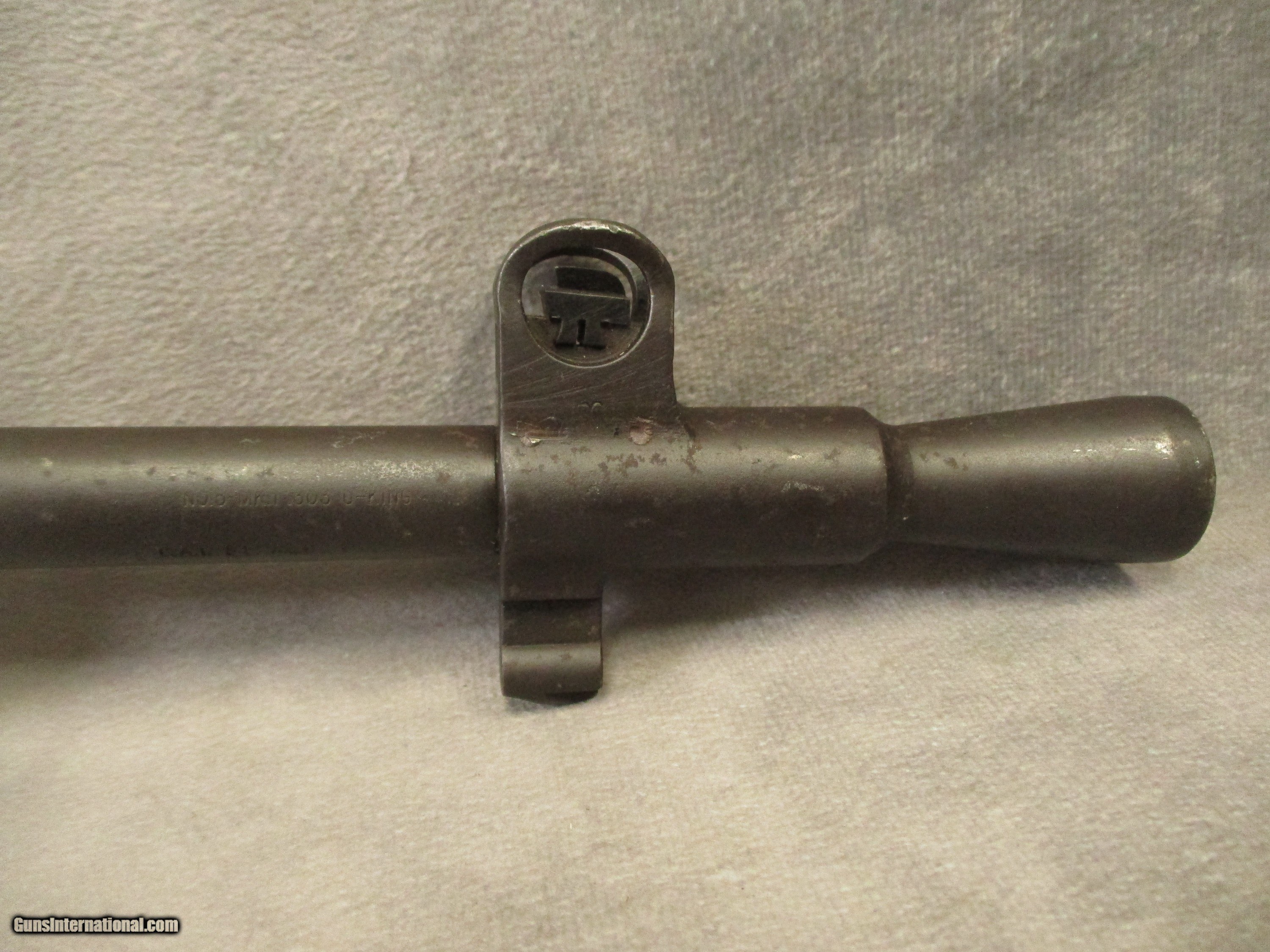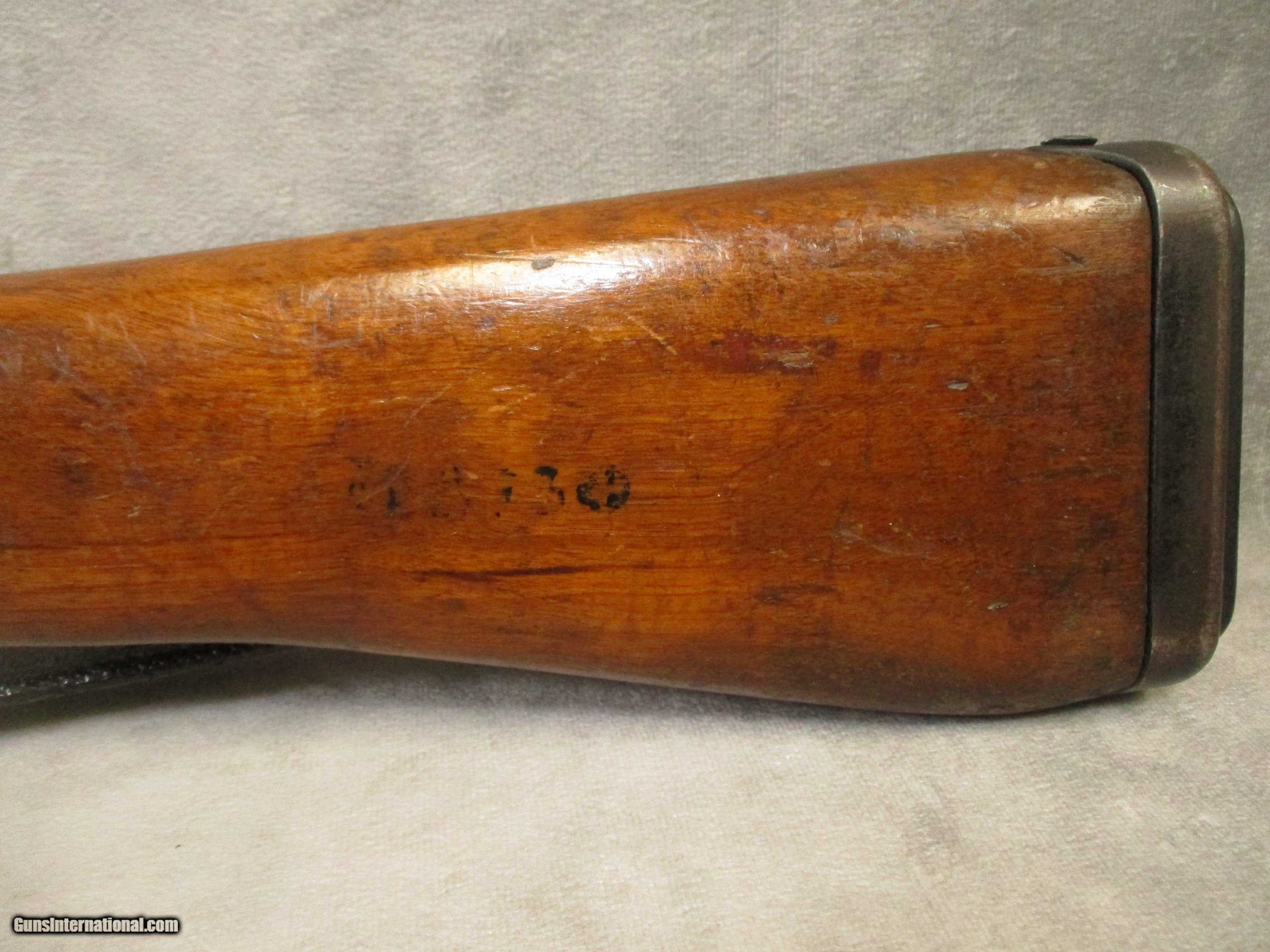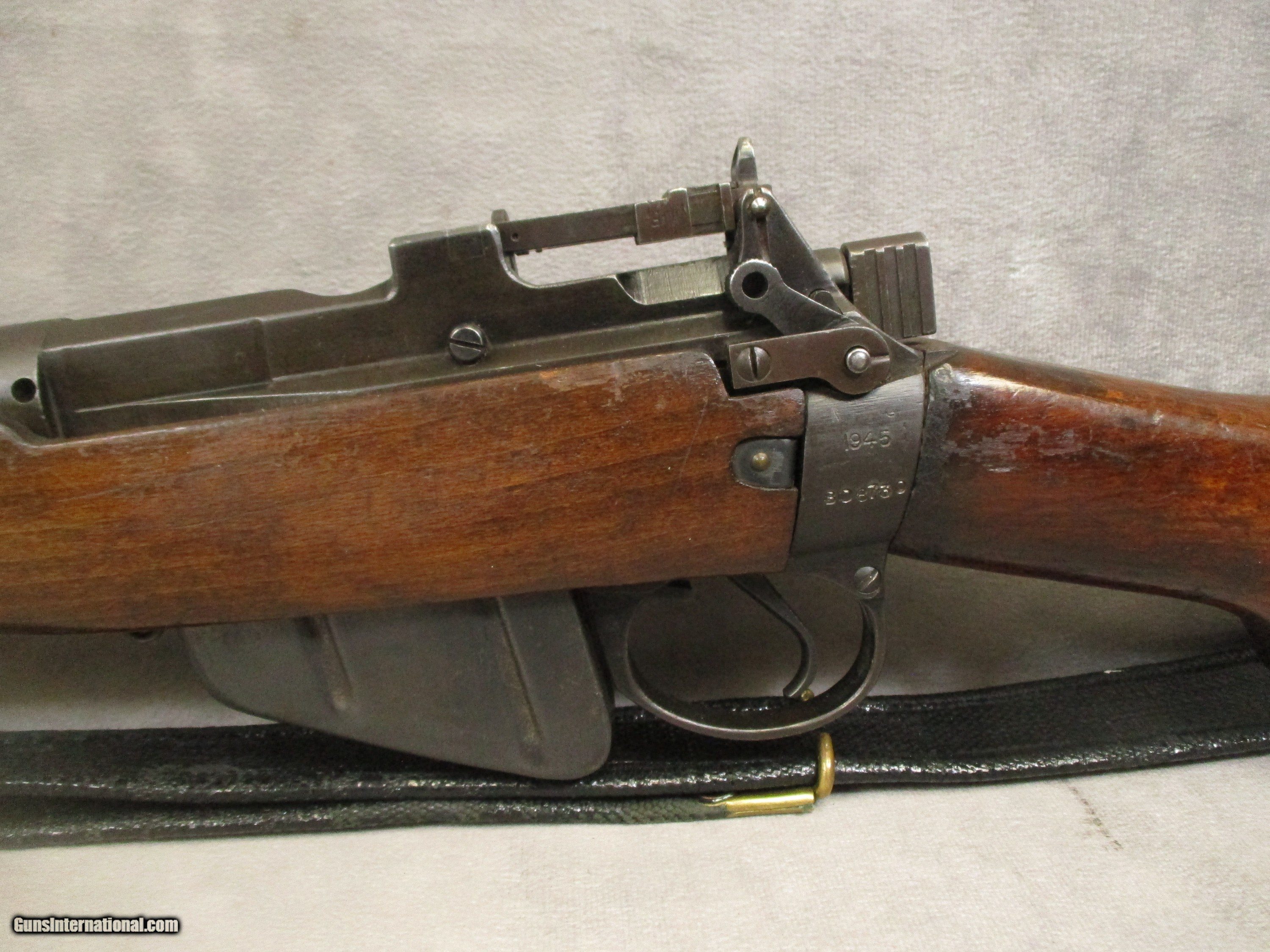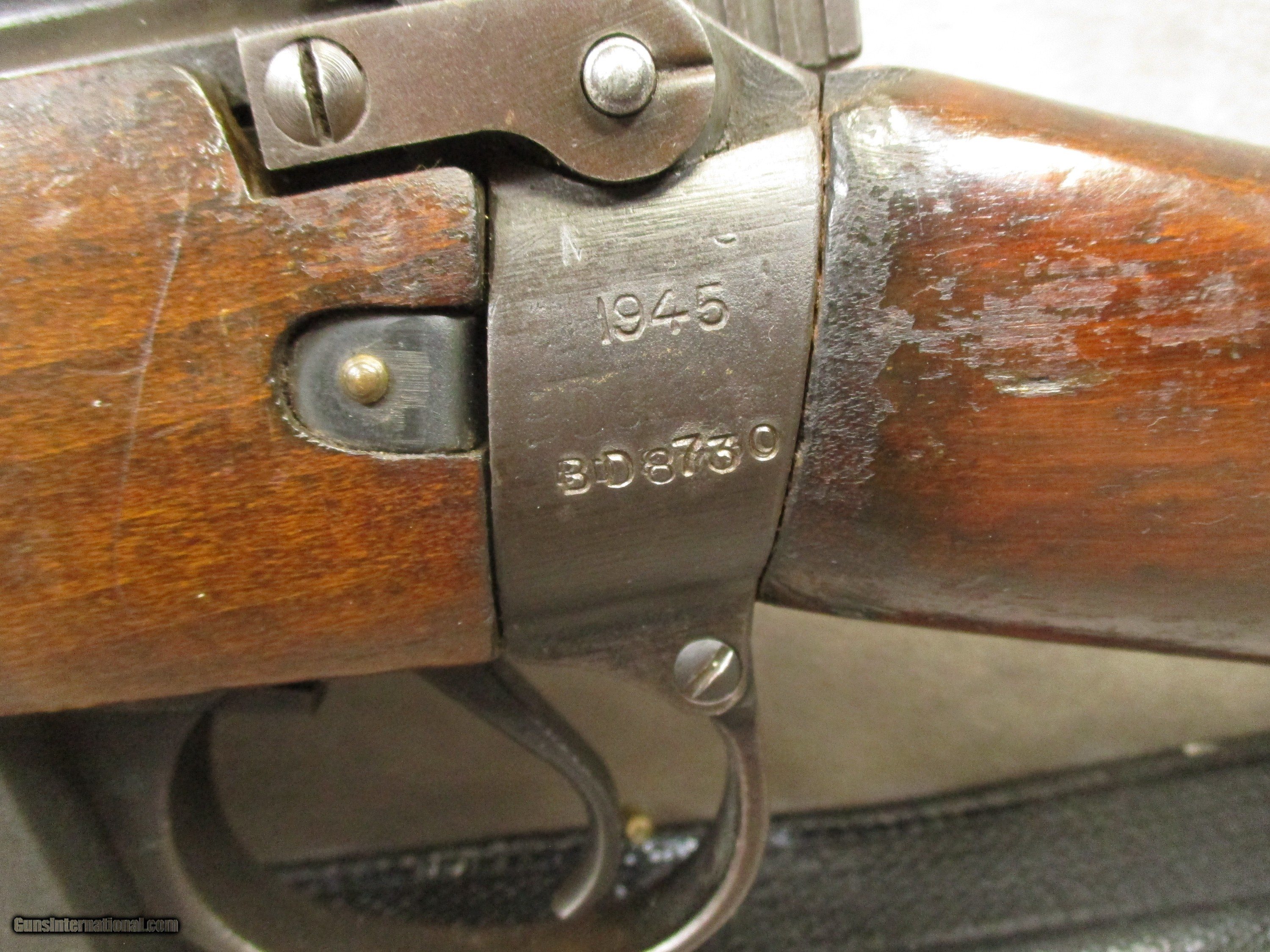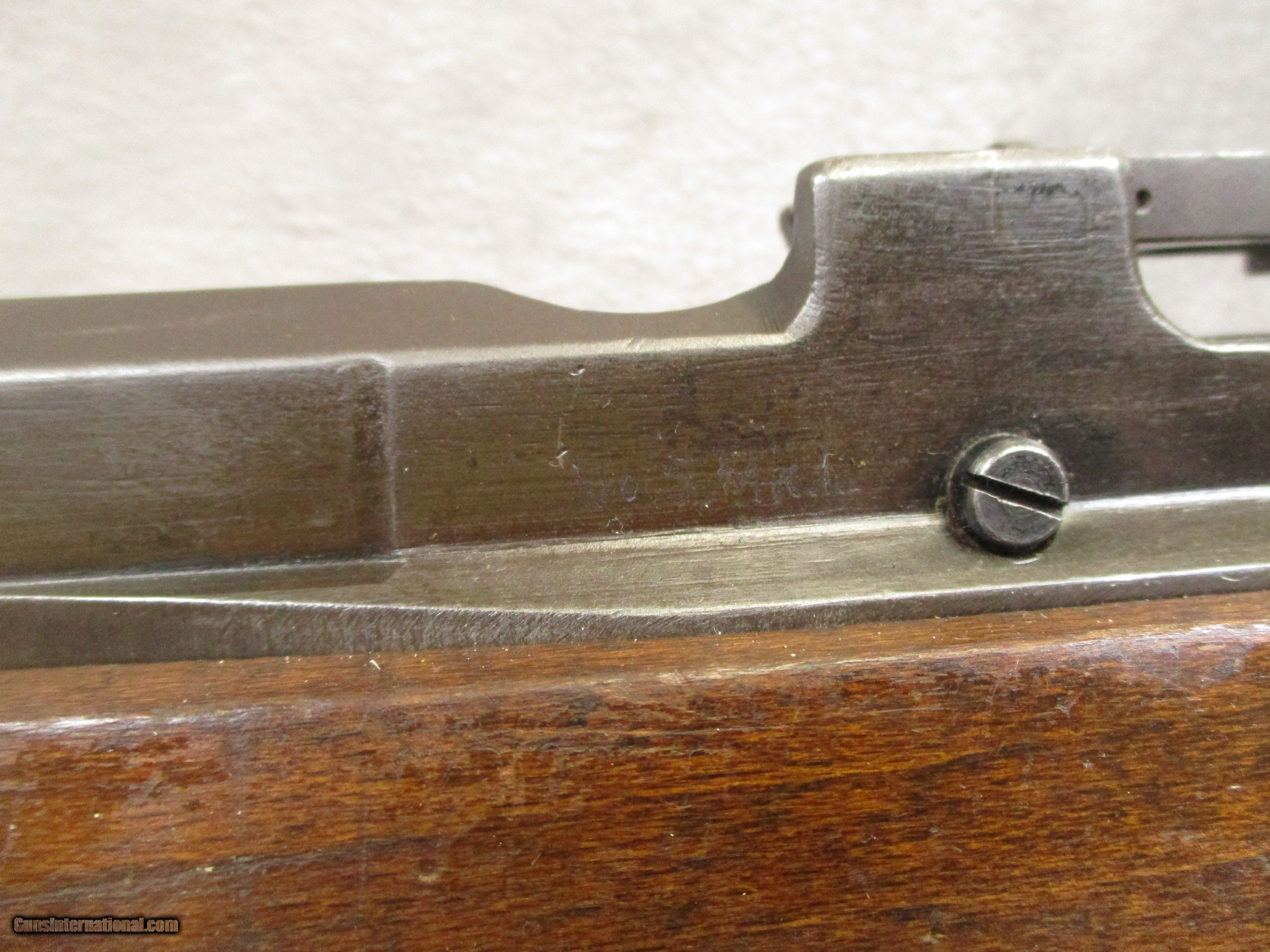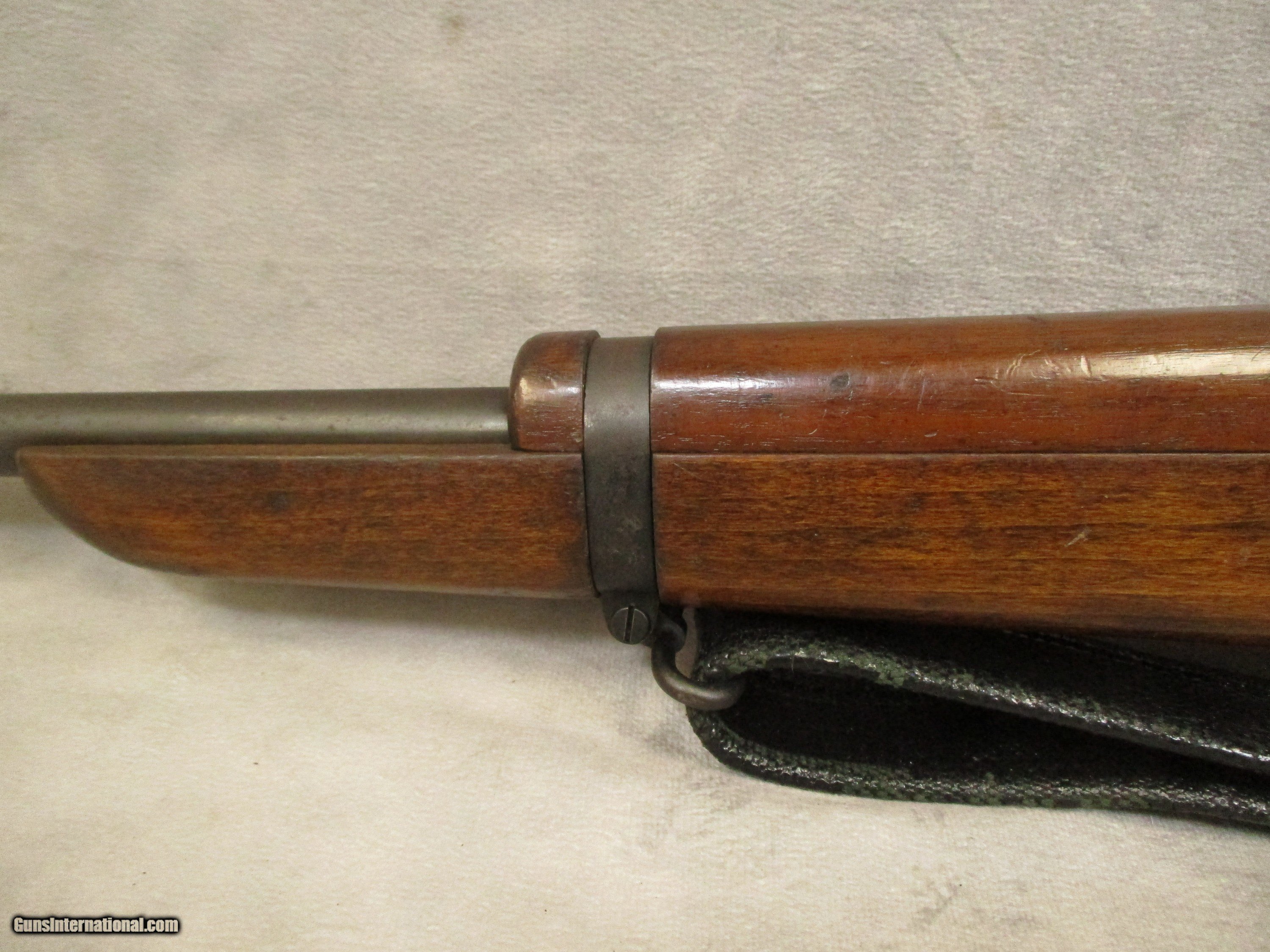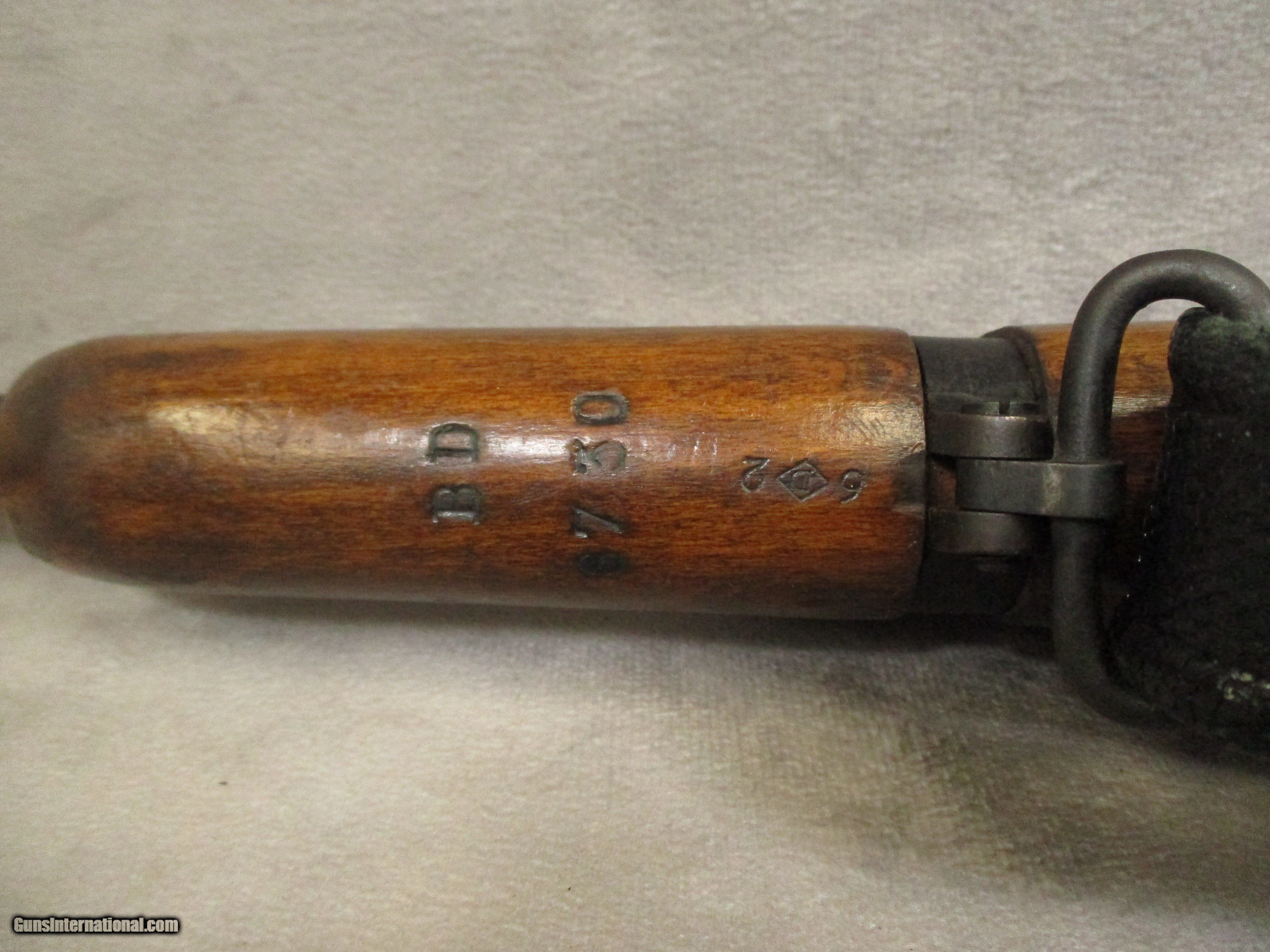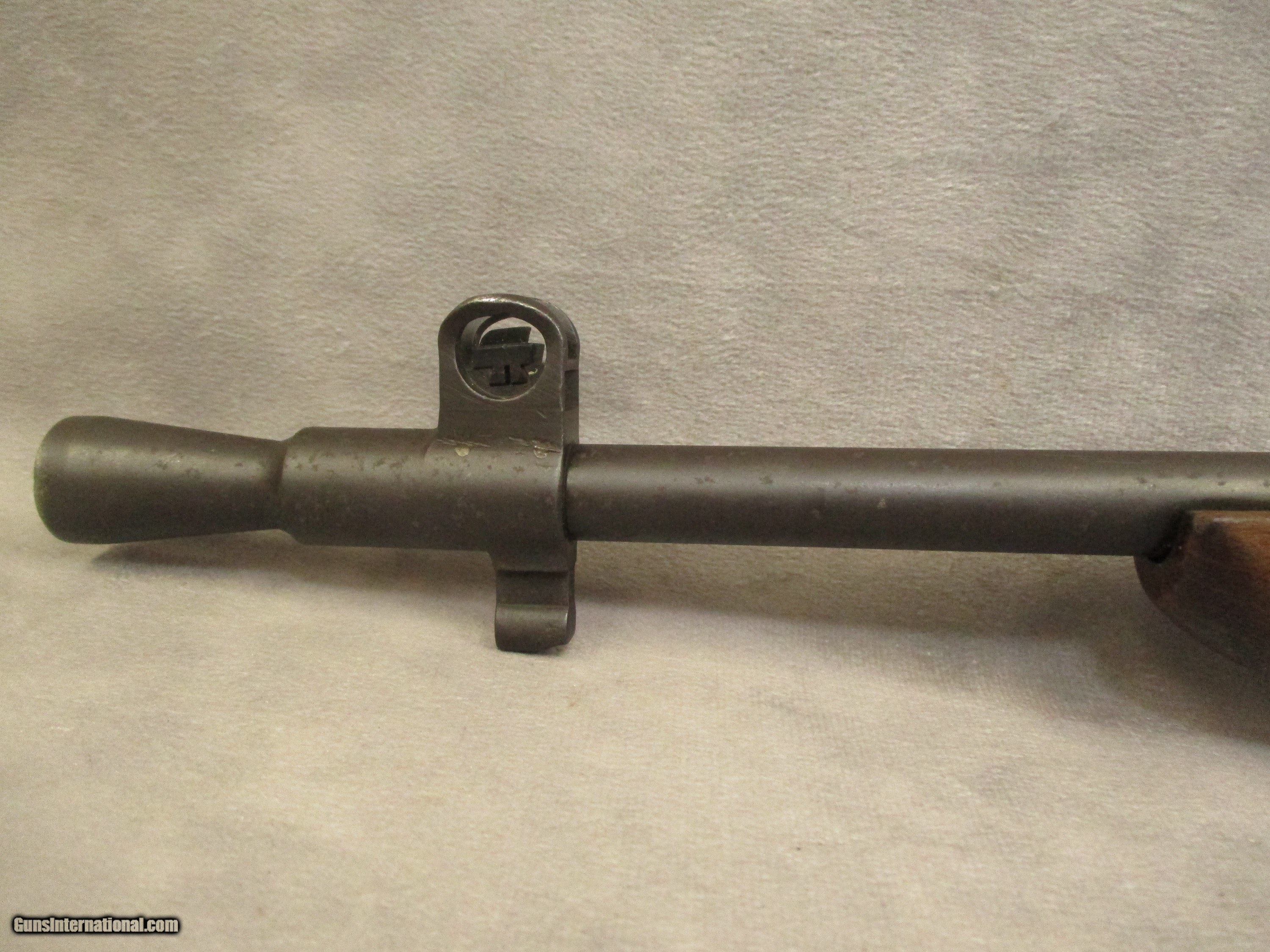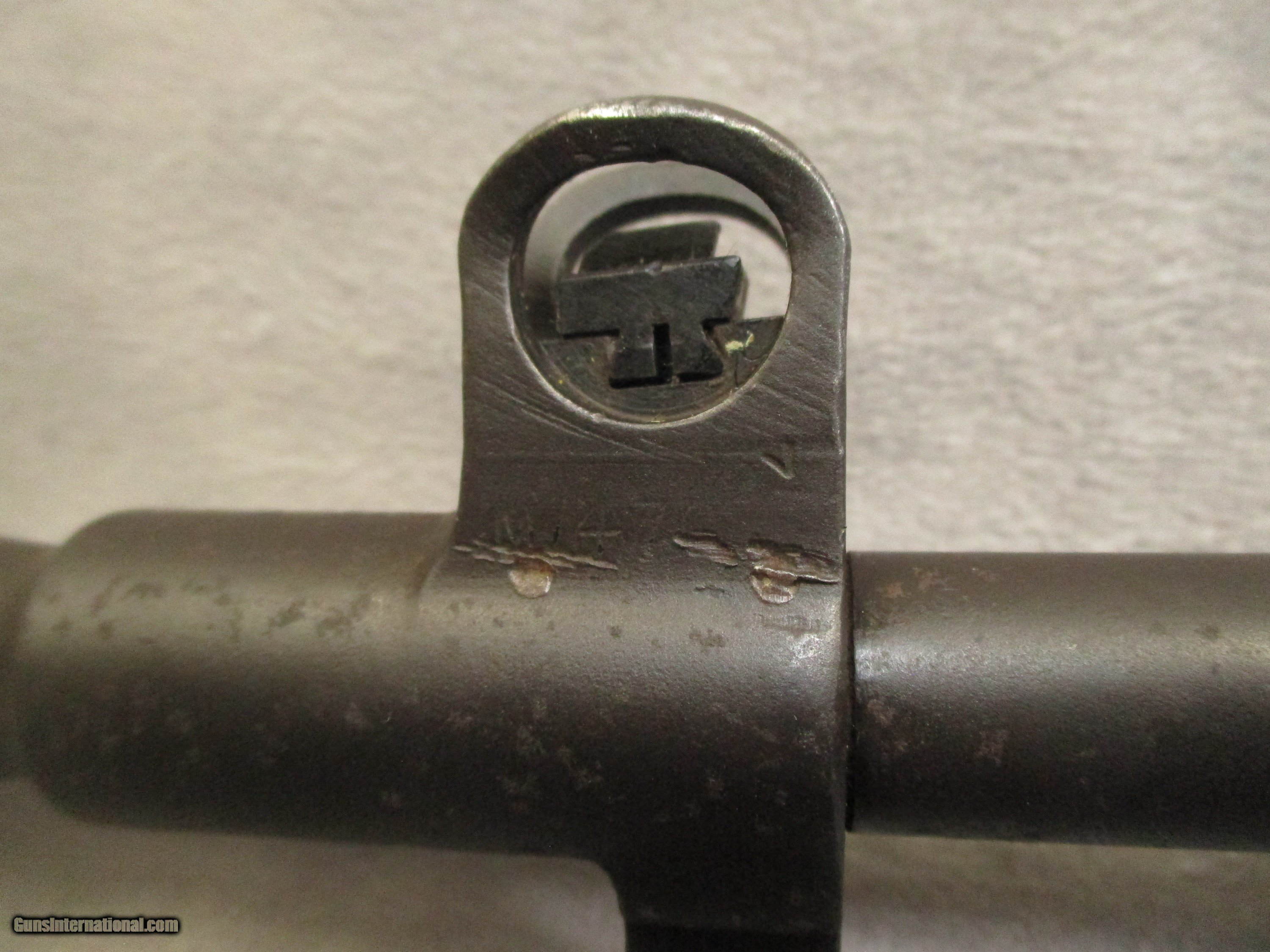Your Session is Ending
 The server has not detected any activity for the last 3 hours.
For your security, your session will expire in 2 minutes and you will be redirected to the Sign In page.
Would you like to stay signed in?
The server has not detected any activity for the last 3 hours.
For your security, your session will expire in 2 minutes and you will be redirected to the Sign In page.
Would you like to stay signed in?
Lee-Enfield No. 5 Mk. 1 .303 British Jungle Carbine, BSA Shirley, 1945 for sale
Lee-Enfield No. 5 Mk. 1 .303 British Jungle Carbine, BSA Shirley, 1945 for sale
Guns International #: 103160384
Seller's Inventory #: 25050243
Category - Enfield Rifles
- Military Rifles - British
Lee-Enfield No. 5 Mk. 1 .303 British Jungle Carbine, BSA Shirley, 1945
Description:
This is one of the most famous bolt-action rifles ever made. The Lee-Enfield served the British empire in one model or another from around the turn-of-the-century to the 1990s. They are still used in certain parts of the world, particularly the Middle East. Despite being surpassed by semi-auto rifles in other countries, the Lee-Enfield is an excellent design with many advantages over other bolt action designs. It’s cock-on-closing feature enabled fast, well-aimed fire. During some of the early battles of World War 1, British troops engaging in massed fire tactics with the Lee-Enfield No. 1 Mk. III, convinced attacking German soldiers that their opponents were equipped with machine guns. The rifles generous capacity of 10 rounds allowed British soldiers to perform what was called the “mad minute,” wherein the soldier would fire 20 to 30 aimed rounds in 60 seconds. Indeed, the current world record for aimed, bolt-action was set in 1914 by an instructor in the British Army who placed 38 rounds into a 12-inch-wide target at 300 yards in 1 minute. Imagine having to attempt such a feat today.
During World War 2, Lee-Enfield rifles were used by the British in the North African, Mediterranean, European, and China-Burma-India (CBI) theaters. It was during early operations in the latter theater that a few issues with the No.1 and No.4 rifles began to crop up. At a length of over 44 inches, the No. 1 Mk III and No. 4 Mk I were rather too long to handle in the dense jungle foliage. By comparison, the Japanese Type 99 rifle had an equal length of 44 inches while the older Type 38 rifle was even longer at whopping 50.2 inches in length. With a loaded weight of near 10 lbs., the standard Lee-Enfield, combined with the rest of a British soldier’s kit, would have been fairly difficult to trek long distances through the jungle given the sweltering heat. So, in 1942, work began on creating a carbine version of the No. 4 rifle suitable for use in the jungles of India and Southeast Asia. The final result of this process came in March of 1944 and was designated as the No. 5 Mk I. It featured a shorter barrel with an integral wide-cone flash hider, a unique butt pad, a shorter fore end, and a modified rear sight. The aperture battle sight was calibrated for 300 yards, and the ladder aperture sight was calibrated for 200 – 800 yards in 100-yard increments. Lightening cuts were made to the receiver and barrel, which, along the shorter barrel and fore end, helped get the weight down 7 lbs. unloaded.
The new “Jungle Carbine”, as it was unofficially named, certainly looked the part, but unfortunately, several aspects of its design combined to make the rifle unsuitable for military use in the long run. The first issue was the so-called “wandering zero”. Essentially the carbine would, after so many rounds, begin shooting to a different point of impact. The most likely culprit was the lightening cuts made to the original No. 4 design. Armorers in Southeast Asia found that simply replacing the No. 5 receiver with that of a No. 4 solved the issue. It should be noted today that modern day collectors of Lee-Enfield rifles do not note any notable issues with a wandering zero. Whether the issue was genuine or just something that afflicted only the earliest production rifles may never be known. However, the other issues that affected the No. 5 carbine are very much real. Unlike modern recoil pads, the No. 5 butt pad noticeably reduced the contact area with the user’s shoulder. Inevitably, this increased the amount of felt recoil in the carbine. Another issue with the butt pad is that the rubber material used was a very poor choice as it had a tendency to harden over time resulting in the pad having the consistency of solid steel.
In official recoil tests, the longer No. 4 rifle yielded 10.06 ft-lbf. average free recoil energy, while the No. 5 developed 14.12 ft-lbf. Of the extra 4.06 ft-lbf. of recoil energy, 1.44 ft-lbf. was caused by the addition of the flash hider. Another cause of the increased recoil was the use of identical .303 ammunition in the carbine. In the past, during the single-shot, and early bolt-action era, carbines usually utilized not only different sights, but lighter powder charges as well, to keep the felt recoil down. The powder charges used in the Springfield Trapdoor rifle and its carbine variant are a good illustration of this with 70 grains and 55 grains of powder respectively (both cartridges were still referred to as the .45-70 and both used a 405gr bullet). While using the same .303 ammo saved on logistics, this added to the recoil issues as well as creating a noticeable flash despite the flash hider. Another quirk was that due to the unique flash hider, a special bayonet had to be designed for the rifle (a must-have in the jungles when facing opponents who love to make bayonet charges). Ultimately, the issues with the No. 5 Mk. I whether real or not, resulted in production being limited to roughly 251,368 in total, with production ending in 1947. Despite its less glamorous history compared to its predecessors, the No. 5 Mk. I is still popular with collectors thanks to its relatively light weight and the fact that ammo for it is relatively easier to find compared to other military rounds, with only the 7.62x54R and the .30-06 being more common.
The Jungle Carbine depicted here is in good condition overall. It was produced by BSA Shirley in 1945. Like the wartime-built Lee-Enfield No. 4 rifles, this No. 5 at one time sported a finish that was visibly more akin to engine paint than bluing. This type of finish was used as it could be applied quickly so that the rifle could be completed, shipped from the factory, and be issued to the troops. The rifle no longer has that type of finish for the most part, though the receiver seems to be free of rust for the most part. The barrel sports a moderate number of freckles which should clean up easily. The wood is in relatively worn shape – a condition common to military rifles that have actually seen use in the field. The stock might have been refinished, though this is difficult to tell for certain as the serial number on the bottom of the fore end lacks the “wiped” appearance usually associated with a refinish job. The rifle has the Century Arms International import markings on the lower righthand side of the barrel. The barrel has been examined underneath the handguard, and it does indeed have the lightening cuts. The bore is in great shape with deep rifling, though some minor copper fowling may be present. The rifle should prove to be very accurate provided the shooter does their part. It’s worth noting that the stamp M/470 is present on the left side of the front sight base, as well as the back of the bolt handle next to the seral number. It also appears that the M/470 may have been stamped (or at least someone attempted to stamp it) on the receiver wrist as well, just above the year date. Curiously, the serial number seems to have been stamped onto the wrist three times! Apparently, it was originally stamped in an undersized font, restamped again with a larger one, and when that proved to be insufficient (or illegible), the serial was restamped with much larger letters and numbers. The left side of the receiver has the typical “No. 5 Mk I” stenciled in rather than stamped, which was common practice in the manufacture of the No.5. The rifle is currently fitted with a sling which is, to a small extent, shedding the original surface coating.
Despite its issues and short service life, the No.5 represented an important in British firearms design, as it was the last, newly built version of Lee’s original design to enter service (the L42A1 sniper rifle was a conversion of an existing No.4 rifle rechambered in the 7.62 NATO cartridge) before being superseded in service by the L1A1, a semi-auto version of FN’s FAL battle rifle. It’s interesting to compare the No.5 to modern scout rifles. It featured a detachable 10-round magazine, a short barrel with a (not wholly successful) flash hider, an action suitable for a high rate of fire, and sturdy construction. In a way, the No.5 is the forefather of most scout rifles today, such as the Steyr Scout, Ruger Scout Rifle, and Mossberg MVP Scout. While it was ultimately not the basis for those rifles, it is can be seen that the designers of the No.5 were thinking along the same lines as the designers of those later rifles. If it were being designed today, the only changes it would need would be a threaded barrel (for use with either a flash hider or a suppressor), a picatinny rail for a scope, and a synthetic stock. It can be argued that the No.5 was simply ahead of its time.
Rifle Caliber: .303 British
Manufacturer: BSA Shirley
Model: No.5 Mk. I
Serial Number: BD8730
Barrel Length: 18.75 inches (476.25 mm) actual length, 20.5 inches (520.7 mm) with flash hider.
Bore Info: Rifled, 5 grooves, 1:10 inches (1 in 254 mm) LH twist
Ejectors: Manual ejection via bolt operation
Condition: Used - Good
Barrels: Carbon Steel
Barrel Type: Carbine type
Action: Lee-Enfield action; cock-on-closing bolt.
Triggers: Standard Lee-Enfield trigger
Stock: Beech wood
Fore End: Beech wood
Butt Pad: Rubber
LOP: 13.75 inches (349.25 mm)
Finish: Patina
Weight: 7 lbs. 11.9 oz.
Sights: Flip-up aperture rear sight w/ladder, post front, sight radius 22.875 inches (581 mm)
Manufacture Date: 1945
Price: $950.00
Description:
This is one of the most famous bolt-action rifles ever made. The Lee-Enfield served the British empire in one model or another from around the turn-of-the-century to the 1990s. They are still used in certain parts of the world, particularly the Middle East. Despite being surpassed by semi-auto rifles in other countries, the Lee-Enfield is an excellent design with many advantages over other bolt action designs. It’s cock-on-closing feature enabled fast, well-aimed fire. During some of the early battles of World War 1, British troops engaging in massed fire tactics with the Lee-Enfield No. 1 Mk. III, convinced attacking German soldiers that their opponents were equipped with machine guns. The rifles generous capacity of 10 rounds allowed British soldiers to perform what was called the “mad minute,” wherein the soldier would fire 20 to 30 aimed rounds in 60 seconds. Indeed, the current world record for aimed, bolt-action was set in 1914 by an instructor in the British Army who placed 38 rounds into a 12-inch-wide target at 300 yards in 1 minute. Imagine having to attempt such a feat today.
During World War 2, Lee-Enfield rifles were used by the British in the North African, Mediterranean, European, and China-Burma-India (CBI) theaters. It was during early operations in the latter theater that a few issues with the No.1 and No.4 rifles began to crop up. At a length of over 44 inches, the No. 1 Mk III and No. 4 Mk I were rather too long to handle in the dense jungle foliage. By comparison, the Japanese Type 99 rifle had an equal length of 44 inches while the older Type 38 rifle was even longer at whopping 50.2 inches in length. With a loaded weight of near 10 lbs., the standard Lee-Enfield, combined with the rest of a British soldier’s kit, would have been fairly difficult to trek long distances through the jungle given the sweltering heat. So, in 1942, work began on creating a carbine version of the No. 4 rifle suitable for use in the jungles of India and Southeast Asia. The final result of this process came in March of 1944 and was designated as the No. 5 Mk I. It featured a shorter barrel with an integral wide-cone flash hider, a unique butt pad, a shorter fore end, and a modified rear sight. The aperture battle sight was calibrated for 300 yards, and the ladder aperture sight was calibrated for 200 – 800 yards in 100-yard increments. Lightening cuts were made to the receiver and barrel, which, along the shorter barrel and fore end, helped get the weight down 7 lbs. unloaded.
The new “Jungle Carbine”, as it was unofficially named, certainly looked the part, but unfortunately, several aspects of its design combined to make the rifle unsuitable for military use in the long run. The first issue was the so-called “wandering zero”. Essentially the carbine would, after so many rounds, begin shooting to a different point of impact. The most likely culprit was the lightening cuts made to the original No. 4 design. Armorers in Southeast Asia found that simply replacing the No. 5 receiver with that of a No. 4 solved the issue. It should be noted today that modern day collectors of Lee-Enfield rifles do not note any notable issues with a wandering zero. Whether the issue was genuine or just something that afflicted only the earliest production rifles may never be known. However, the other issues that affected the No. 5 carbine are very much real. Unlike modern recoil pads, the No. 5 butt pad noticeably reduced the contact area with the user’s shoulder. Inevitably, this increased the amount of felt recoil in the carbine. Another issue with the butt pad is that the rubber material used was a very poor choice as it had a tendency to harden over time resulting in the pad having the consistency of solid steel.
In official recoil tests, the longer No. 4 rifle yielded 10.06 ft-lbf. average free recoil energy, while the No. 5 developed 14.12 ft-lbf. Of the extra 4.06 ft-lbf. of recoil energy, 1.44 ft-lbf. was caused by the addition of the flash hider. Another cause of the increased recoil was the use of identical .303 ammunition in the carbine. In the past, during the single-shot, and early bolt-action era, carbines usually utilized not only different sights, but lighter powder charges as well, to keep the felt recoil down. The powder charges used in the Springfield Trapdoor rifle and its carbine variant are a good illustration of this with 70 grains and 55 grains of powder respectively (both cartridges were still referred to as the .45-70 and both used a 405gr bullet). While using the same .303 ammo saved on logistics, this added to the recoil issues as well as creating a noticeable flash despite the flash hider. Another quirk was that due to the unique flash hider, a special bayonet had to be designed for the rifle (a must-have in the jungles when facing opponents who love to make bayonet charges). Ultimately, the issues with the No. 5 Mk. I whether real or not, resulted in production being limited to roughly 251,368 in total, with production ending in 1947. Despite its less glamorous history compared to its predecessors, the No. 5 Mk. I is still popular with collectors thanks to its relatively light weight and the fact that ammo for it is relatively easier to find compared to other military rounds, with only the 7.62x54R and the .30-06 being more common.
The Jungle Carbine depicted here is in good condition overall. It was produced by BSA Shirley in 1945. Like the wartime-built Lee-Enfield No. 4 rifles, this No. 5 at one time sported a finish that was visibly more akin to engine paint than bluing. This type of finish was used as it could be applied quickly so that the rifle could be completed, shipped from the factory, and be issued to the troops. The rifle no longer has that type of finish for the most part, though the receiver seems to be free of rust for the most part. The barrel sports a moderate number of freckles which should clean up easily. The wood is in relatively worn shape – a condition common to military rifles that have actually seen use in the field. The stock might have been refinished, though this is difficult to tell for certain as the serial number on the bottom of the fore end lacks the “wiped” appearance usually associated with a refinish job. The rifle has the Century Arms International import markings on the lower righthand side of the barrel. The barrel has been examined underneath the handguard, and it does indeed have the lightening cuts. The bore is in great shape with deep rifling, though some minor copper fowling may be present. The rifle should prove to be very accurate provided the shooter does their part. It’s worth noting that the stamp M/470 is present on the left side of the front sight base, as well as the back of the bolt handle next to the seral number. It also appears that the M/470 may have been stamped (or at least someone attempted to stamp it) on the receiver wrist as well, just above the year date. Curiously, the serial number seems to have been stamped onto the wrist three times! Apparently, it was originally stamped in an undersized font, restamped again with a larger one, and when that proved to be insufficient (or illegible), the serial was restamped with much larger letters and numbers. The left side of the receiver has the typical “No. 5 Mk I” stenciled in rather than stamped, which was common practice in the manufacture of the No.5. The rifle is currently fitted with a sling which is, to a small extent, shedding the original surface coating.
Despite its issues and short service life, the No.5 represented an important in British firearms design, as it was the last, newly built version of Lee’s original design to enter service (the L42A1 sniper rifle was a conversion of an existing No.4 rifle rechambered in the 7.62 NATO cartridge) before being superseded in service by the L1A1, a semi-auto version of FN’s FAL battle rifle. It’s interesting to compare the No.5 to modern scout rifles. It featured a detachable 10-round magazine, a short barrel with a (not wholly successful) flash hider, an action suitable for a high rate of fire, and sturdy construction. In a way, the No.5 is the forefather of most scout rifles today, such as the Steyr Scout, Ruger Scout Rifle, and Mossberg MVP Scout. While it was ultimately not the basis for those rifles, it is can be seen that the designers of the No.5 were thinking along the same lines as the designers of those later rifles. If it were being designed today, the only changes it would need would be a threaded barrel (for use with either a flash hider or a suppressor), a picatinny rail for a scope, and a synthetic stock. It can be argued that the No.5 was simply ahead of its time.
Rifle Caliber: .303 British
Manufacturer: BSA Shirley
Model: No.5 Mk. I
Serial Number: BD8730
Barrel Length: 18.75 inches (476.25 mm) actual length, 20.5 inches (520.7 mm) with flash hider.
Bore Info: Rifled, 5 grooves, 1:10 inches (1 in 254 mm) LH twist
Ejectors: Manual ejection via bolt operation
Condition: Used - Good
Barrels: Carbon Steel
Barrel Type: Carbine type
Action: Lee-Enfield action; cock-on-closing bolt.
Triggers: Standard Lee-Enfield trigger
Stock: Beech wood
Fore End: Beech wood
Butt Pad: Rubber
LOP: 13.75 inches (349.25 mm)
Finish: Patina
Weight: 7 lbs. 11.9 oz.
Sights: Flip-up aperture rear sight w/ladder, post front, sight radius 22.875 inches (581 mm)
Manufacture Date: 1945
Price: $950.00
Contact Seller
Click Photo to Enlarge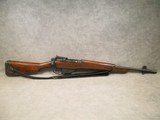
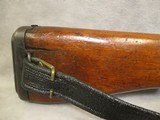
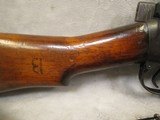
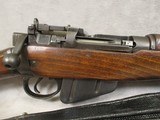
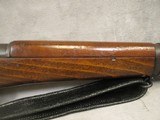
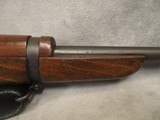
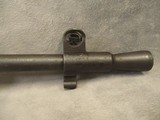
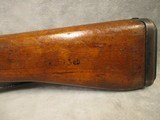
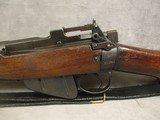
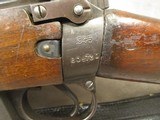
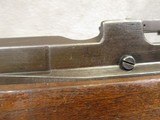
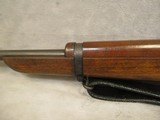
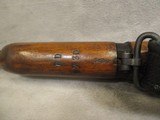
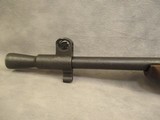
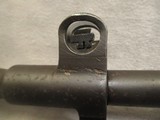
|
Guns International #: 103160384
Category - Enfield Rifles
- Military Rifles - British
Lee-Enfield No. 5 Mk. 1 .303 British Jungle Carbine, BSA Shirley, 1945
Description: This is one of the most famous bolt-action rifles ever made. The Lee-Enfield served the British empire in one model or another from around the turn-of-the-century to the 1990s. They are still used in certain parts of the world, particularly the Middle East. Despite being surpassed by semi-auto rifles in other countries, the Lee-Enfield is an excellent design with many advantages over other bolt action designs. It’s cock-on-closing feature enabled fast, well-aimed fire. During some of the early battles of World War 1, British troops engaging in massed fire tactics with the Lee-Enfield No. 1 Mk. III, convinced attacking German soldiers that their opponents were equipped with machine guns. The rifles generous capacity of 10 rounds allowed British soldiers to perform what was called the “mad minute,” wherein the soldier would fire 20 to 30 aimed rounds in 60 seconds. Indeed, the current world record for aimed, bolt-action was set in 1914 by an instructor in the British Army who placed 38 rounds into a 12-inch-wide target at 300 yards in 1 minute. Imagine having to attempt such a feat today. During World War 2, Lee-Enfield rifles were used by the British in the North African, Mediterranean, European, and China-Burma-India (CBI) theaters. It was during early operations in the latter theater that a few issues with the No.1 and No.4 rifles began to crop up. At a length of over 44 inches, the No. 1 Mk III and No. 4 Mk I were rather too long to handle in the dense jungle foliage. By comparison, the Japanese Type 99 rifle had an equal length of 44 inches while the older Type 38 rifle was even longer at whopping 50.2 inches in length. With a loaded weight of near 10 lbs., the standard Lee-Enfield, combined with the rest of a British soldier’s kit, would have been fairly difficult to trek long distances through the jungle given the sweltering heat. So, in 1942, work began on creating a carbine version of the No. 4 rifle suitable for use in the jungles of India and Southeast Asia. The final result of this process came in March of 1944 and was designated as the No. 5 Mk I. It featured a shorter barrel with an integral wide-cone flash hider, a unique butt pad, a shorter fore end, and a modified rear sight. The aperture battle sight was calibrated for 300 yards, and the ladder aperture sight was calibrated for 200 – 800 yards in 100-yard increments. Lightening cuts were made to the receiver and barrel, which, along the shorter barrel and fore end, helped get the weight down 7 lbs. unloaded. The new “Jungle Carbine”, as it was unofficially named, certainly looked the part, but unfortunately, several aspects of its design combined to make the rifle unsuitable for military use in the long run. The first issue was the so-called “wandering zero”. Essentially the carbine would, after so many rounds, begin shooting to a different point of impact. The most likely culprit was the lightening cuts made to the original No. 4 design. Armorers in Southeast Asia found that simply replacing the No. 5 receiver with that of a No. 4 solved the issue. It should be noted today that modern day collectors of Lee-Enfield rifles do not note any notable issues with a wandering zero. Whether the issue was genuine or just something that afflicted only the earliest production rifles may never be known. However, the other issues that affected the No. 5 carbine are very much real. Unlike modern recoil pads, the No. 5 butt pad noticeably reduced the contact area with the user’s shoulder. Inevitably, this increased the amount of felt recoil in the carbine. Another issue with the butt pad is that the rubber material used was a very poor choice as it had a tendency to harden over time resulting in the pad having the consistency of solid steel. In official recoil tests, the longer No. 4 rifle yielded 10.06 ft-lbf. average free recoil energy, while the No. 5 developed 14.12 ft-lbf. Of the extra 4.06 ft-lbf. of recoil energy, 1.44 ft-lbf. was caused by the addition of the flash hider. Another cause of the increased recoil was the use of identical .303 ammunition in the carbine. In the past, during the single-shot, and early bolt-action era, carbines usually utilized not only different sights, but lighter powder charges as well, to keep the felt recoil down. The powder charges used in the Springfield Trapdoor rifle and its carbine variant are a good illustration of this with 70 grains and 55 grains of powder respectively (both cartridges were still referred to as the .45-70 and both used a 405gr bullet). While using the same .303 ammo saved on logistics, this added to the recoil issues as well as creating a noticeable flash despite the flash hider. Another quirk was that due to the unique flash hider, a special bayonet had to be designed for the rifle (a must-have in the jungles when facing opponents who love to make bayonet charges). Ultimately, the issues with the No. 5 Mk. I whether real or not, resulted in production being limited to roughly 251,368 in total, with production ending in 1947. Despite its less glamorous history compared to its predecessors, the No. 5 Mk. I is still popular with collectors thanks to its relatively light weight and the fact that ammo for it is relatively easier to find compared to other military rounds, with only the 7.62x54R and the .30-06 being more common. The Jungle Carbine depicted here is in good condition overall. It was produced by BSA Shirley in 1945. Like the wartime-built Lee-Enfield No. 4 rifles, this No. 5 at one time sported a finish that was visibly more akin to engine paint than bluing. This type of finish was used as it could be applied quickly so that the rifle could be completed, shipped from the factory, and be issued to the troops. The rifle no longer has that type of finish for the most part, though the receiver seems to be free of rust for the most part. The barrel sports a moderate number of freckles which should clean up easily. The wood is in relatively worn shape – a condition common to military rifles that have actually seen use in the field. The stock might have been refinished, though this is difficult to tell for certain as the serial number on the bottom of the fore end lacks the “wiped” appearance usually associated with a refinish job. The rifle has the Century Arms International import markings on the lower righthand side of the barrel. The barrel has been examined underneath the handguard, and it does indeed have the lightening cuts. The bore is in great shape with deep rifling, though some minor copper fowling may be present. The rifle should prove to be very accurate provided the shooter does their part. It’s worth noting that the stamp M/470 is present on the left side of the front sight base, as well as the back of the bolt handle next to the seral number. It also appears that the M/470 may have been stamped (or at least someone attempted to stamp it) on the receiver wrist as well, just above the year date. Curiously, the serial number seems to have been stamped onto the wrist three times! Apparently, it was originally stamped in an undersized font, restamped again with a larger one, and when that proved to be insufficient (or illegible), the serial was restamped with much larger letters and numbers. The left side of the receiver has the typical “No. 5 Mk I” stenciled in rather than stamped, which was common practice in the manufacture of the No.5. The rifle is currently fitted with a sling which is, to a small extent, shedding the original surface coating. Despite its issues and short service life, the No.5 represented an important in British firearms design, as it was the last, newly built version of Lee’s original design to enter service (the L42A1 sniper rifle was a conversion of an existing No.4 rifle rechambered in the 7.62 NATO cartridge) before being superseded in service by the L1A1, a semi-auto version of FN’s FAL battle rifle. It’s interesting to compare the No.5 to modern scout rifles. It featured a detachable 10-round magazine, a short barrel with a (not wholly successful) flash hider, an action suitable for a high rate of fire, and sturdy construction. In a way, the No.5 is the forefather of most scout rifles today, such as the Steyr Scout, Ruger Scout Rifle, and Mossberg MVP Scout. While it was ultimately not the basis for those rifles, it is can be seen that the designers of the No.5 were thinking along the same lines as the designers of those later rifles. If it were being designed today, the only changes it would need would be a threaded barrel (for use with either a flash hider or a suppressor), a picatinny rail for a scope, and a synthetic stock. It can be argued that the No.5 was simply ahead of its time. Rifle Caliber: .303 British Manufacturer: BSA Shirley Model: No.5 Mk. I Serial Number: BD8730 Barrel Length: 18.75 inches (476.25 mm) actual length, 20.5 inches (520.7 mm) with flash hider. Bore Info: Rifled, 5 grooves, 1:10 inches (1 in 254 mm) LH twist Ejectors: Manual ejection via bolt operation Condition: Used - Good Barrels: Carbon Steel Barrel Type: Carbine type Action: Lee-Enfield action; cock-on-closing bolt. Triggers: Standard Lee-Enfield trigger Stock: Beech wood Fore End: Beech wood Butt Pad: Rubber LOP: 13.75 inches (349.25 mm) Finish: Patina Weight: 7 lbs. 11.9 oz. Sights: Flip-up aperture rear sight w/ladder, post front, sight radius 22.875 inches (581 mm) Manufacture Date: 1945 Price: $950.00 Contact Seller |
Guns International #: 103160384
Seller's Inventory #: 25050243
Category - Enfield Rifles
- Military Rifles - British
Lee-Enfield No. 5 Mk. 1 .303 British Jungle Carbine, BSA Shirley, 1945
Description:
This is one of the most famous bolt-action rifles ever made. The Lee-Enfield served the British empire in one model or another from around the turn-of-the-century to the 1990s. They are still used in certain parts of the world, particularly the Middle East. Despite being surpassed by semi-auto rifles in other countries, the Lee-Enfield is an excellent design with many advantages over other bolt action designs. It’s cock-on-closing feature enabled fast, well-aimed fire. During some of the early battles of World War 1, British troops engaging in massed fire tactics with the Lee-Enfield No. 1 Mk. III, convinced attacking German soldiers that their opponents were equipped with machine guns. The rifles generous capacity of 10 rounds allowed British soldiers to perform what was called the “mad minute,” wherein the soldier would fire 20 to 30 aimed rounds in 60 seconds. Indeed, the current world record for aimed, bolt-action was set in 1914 by an instructor in the British Army who placed 38 rounds into a 12-inch-wide target at 300 yards in 1 minute. Imagine having to attempt such a feat today.
During World War 2, Lee-Enfield rifles were used by the British in the North African, Mediterranean, European, and China-Burma-India (CBI) theaters. It was during early operations in the latter theater that a few issues with the No.1 and No.4 rifles began to crop up. At a length of over 44 inches, the No. 1 Mk III and No. 4 Mk I were rather too long to handle in the dense jungle foliage. By comparison, the Japanese Type 99 rifle had an equal length of 44 inches while the older Type 38 rifle was even longer at whopping 50.2 inches in length. With a loaded weight of near 10 lbs., the standard Lee-Enfield, combined with the rest of a British soldier’s kit, would have been fairly difficult to trek long distances through the jungle given the sweltering heat. So, in 1942, work began on creating a carbine version of the No. 4 rifle suitable for use in the jungles of India and Southeast Asia. The final result of this process came in March of 1944 and was designated as the No. 5 Mk I. It featured a shorter barrel with an integral wide-cone flash hider, a unique butt pad, a shorter fore end, and a modified rear sight. The aperture battle sight was calibrated for 300 yards, and the ladder aperture sight was calibrated for 200 – 800 yards in 100-yard increments. Lightening cuts were made to the receiver and barrel, which, along the shorter barrel and fore end, helped get the weight down 7 lbs. unloaded.
The new “Jungle Carbine”, as it was unofficially named, certainly looked the part, but unfortunately, several aspects of its design combined to make the rifle unsuitable for military use in the long run. The first issue was the so-called “wandering zero”. Essentially the carbine would, after so many rounds, begin shooting to a different point of impact. The most likely culprit was the lightening cuts made to the original No. 4 design. Armorers in Southeast Asia found that simply replacing the No. 5 receiver with that of a No. 4 solved the issue. It should be noted today that modern day collectors of Lee-Enfield rifles do not note any notable issues with a wandering zero. Whether the issue was genuine or just something that afflicted only the earliest production rifles may never be known. However, the other issues that affected the No. 5 carbine are very much real. Unlike modern recoil pads, the No. 5 butt pad noticeably reduced the contact area with the user’s shoulder. Inevitably, this increased the amount of felt recoil in the carbine. Another issue with the butt pad is that the rubber material used was a very poor choice as it had a tendency to harden over time resulting in the pad having the consistency of solid steel.
In official recoil tests, the longer No. 4 rifle yielded 10.06 ft-lbf. average free recoil energy, while the No. 5 developed 14.12 ft-lbf. Of the extra 4.06 ft-lbf. of recoil energy, 1.44 ft-lbf. was caused by the addition of the flash hider. Another cause of the increased recoil was the use of identical .303 ammunition in the carbine. In the past, during the single-shot, and early bolt-action era, carbines usually utilized not only different sights, but lighter powder charges as well, to keep the felt recoil down. The powder charges used in the Springfield Trapdoor rifle and its carbine variant are a good illustration of this with 70 grains and 55 grains of powder respectively (both cartridges were still referred to as the .45-70 and both used a 405gr bullet). While using the same .303 ammo saved on logistics, this added to the recoil issues as well as creating a noticeable flash despite the flash hider. Another quirk was that due to the unique flash hider, a special bayonet had to be designed for the rifle (a must-have in the jungles when facing opponents who love to make bayonet charges). Ultimately, the issues with the No. 5 Mk. I whether real or not, resulted in production being limited to roughly 251,368 in total, with production ending in 1947. Despite its less glamorous history compared to its predecessors, the No. 5 Mk. I is still popular with collectors thanks to its relatively light weight and the fact that ammo for it is relatively easier to find compared to other military rounds, with only the 7.62x54R and the .30-06 being more common.
The Jungle Carbine depicted here is in good condition overall. It was produced by BSA Shirley in 1945. Like the wartime-built Lee-Enfield No. 4 rifles, this No. 5 at one time sported a finish that was visibly more akin to engine paint than bluing. This type of finish was used as it could be applied quickly so that the rifle could be completed, shipped from the factory, and be issued to the troops. The rifle no longer has that type of finish for the most part, though the receiver seems to be free of rust for the most part. The barrel sports a moderate number of freckles which should clean up easily. The wood is in relatively worn shape – a condition common to military rifles that have actually seen use in the field. The stock might have been refinished, though this is difficult to tell for certain as the serial number on the bottom of the fore end lacks the “wiped” appearance usually associated with a refinish job. The rifle has the Century Arms International import markings on the lower righthand side of the barrel. The barrel has been examined underneath the handguard, and it does indeed have the lightening cuts. The bore is in great shape with deep rifling, though some minor copper fowling may be present. The rifle should prove to be very accurate provided the shooter does their part. It’s worth noting that the stamp M/470 is present on the left side of the front sight base, as well as the back of the bolt handle next to the seral number. It also appears that the M/470 may have been stamped (or at least someone attempted to stamp it) on the receiver wrist as well, just above the year date. Curiously, the serial number seems to have been stamped onto the wrist three times! Apparently, it was originally stamped in an undersized font, restamped again with a larger one, and when that proved to be insufficient (or illegible), the serial was restamped with much larger letters and numbers. The left side of the receiver has the typical “No. 5 Mk I” stenciled in rather than stamped, which was common practice in the manufacture of the No.5. The rifle is currently fitted with a sling which is, to a small extent, shedding the original surface coating.
Despite its issues and short service life, the No.5 represented an important in British firearms design, as it was the last, newly built version of Lee’s original design to enter service (the L42A1 sniper rifle was a conversion of an existing No.4 rifle rechambered in the 7.62 NATO cartridge) before being superseded in service by the L1A1, a semi-auto version of FN’s FAL battle rifle. It’s interesting to compare the No.5 to modern scout rifles. It featured a detachable 10-round magazine, a short barrel with a (not wholly successful) flash hider, an action suitable for a high rate of fire, and sturdy construction. In a way, the No.5 is the forefather of most scout rifles today, such as the Steyr Scout, Ruger Scout Rifle, and Mossberg MVP Scout. While it was ultimately not the basis for those rifles, it is can be seen that the designers of the No.5 were thinking along the same lines as the designers of those later rifles. If it were being designed today, the only changes it would need would be a threaded barrel (for use with either a flash hider or a suppressor), a picatinny rail for a scope, and a synthetic stock. It can be argued that the No.5 was simply ahead of its time.
Rifle Caliber: .303 British
Manufacturer: BSA Shirley
Model: No.5 Mk. I
Serial Number: BD8730
Barrel Length: 18.75 inches (476.25 mm) actual length, 20.5 inches (520.7 mm) with flash hider.
Bore Info: Rifled, 5 grooves, 1:10 inches (1 in 254 mm) LH twist
Ejectors: Manual ejection via bolt operation
Condition: Used - Good
Barrels: Carbon Steel
Barrel Type: Carbine type
Action: Lee-Enfield action; cock-on-closing bolt.
Triggers: Standard Lee-Enfield trigger
Stock: Beech wood
Fore End: Beech wood
Butt Pad: Rubber
LOP: 13.75 inches (349.25 mm)
Finish: Patina
Weight: 7 lbs. 11.9 oz.
Sights: Flip-up aperture rear sight w/ladder, post front, sight radius 22.875 inches (581 mm)
Manufacture Date: 1945
Price: $950.00
Description:
This is one of the most famous bolt-action rifles ever made. The Lee-Enfield served the British empire in one model or another from around the turn-of-the-century to the 1990s. They are still used in certain parts of the world, particularly the Middle East. Despite being surpassed by semi-auto rifles in other countries, the Lee-Enfield is an excellent design with many advantages over other bolt action designs. It’s cock-on-closing feature enabled fast, well-aimed fire. During some of the early battles of World War 1, British troops engaging in massed fire tactics with the Lee-Enfield No. 1 Mk. III, convinced attacking German soldiers that their opponents were equipped with machine guns. The rifles generous capacity of 10 rounds allowed British soldiers to perform what was called the “mad minute,” wherein the soldier would fire 20 to 30 aimed rounds in 60 seconds. Indeed, the current world record for aimed, bolt-action was set in 1914 by an instructor in the British Army who placed 38 rounds into a 12-inch-wide target at 300 yards in 1 minute. Imagine having to attempt such a feat today.
During World War 2, Lee-Enfield rifles were used by the British in the North African, Mediterranean, European, and China-Burma-India (CBI) theaters. It was during early operations in the latter theater that a few issues with the No.1 and No.4 rifles began to crop up. At a length of over 44 inches, the No. 1 Mk III and No. 4 Mk I were rather too long to handle in the dense jungle foliage. By comparison, the Japanese Type 99 rifle had an equal length of 44 inches while the older Type 38 rifle was even longer at whopping 50.2 inches in length. With a loaded weight of near 10 lbs., the standard Lee-Enfield, combined with the rest of a British soldier’s kit, would have been fairly difficult to trek long distances through the jungle given the sweltering heat. So, in 1942, work began on creating a carbine version of the No. 4 rifle suitable for use in the jungles of India and Southeast Asia. The final result of this process came in March of 1944 and was designated as the No. 5 Mk I. It featured a shorter barrel with an integral wide-cone flash hider, a unique butt pad, a shorter fore end, and a modified rear sight. The aperture battle sight was calibrated for 300 yards, and the ladder aperture sight was calibrated for 200 – 800 yards in 100-yard increments. Lightening cuts were made to the receiver and barrel, which, along the shorter barrel and fore end, helped get the weight down 7 lbs. unloaded.
The new “Jungle Carbine”, as it was unofficially named, certainly looked the part, but unfortunately, several aspects of its design combined to make the rifle unsuitable for military use in the long run. The first issue was the so-called “wandering zero”. Essentially the carbine would, after so many rounds, begin shooting to a different point of impact. The most likely culprit was the lightening cuts made to the original No. 4 design. Armorers in Southeast Asia found that simply replacing the No. 5 receiver with that of a No. 4 solved the issue. It should be noted today that modern day collectors of Lee-Enfield rifles do not note any notable issues with a wandering zero. Whether the issue was genuine or just something that afflicted only the earliest production rifles may never be known. However, the other issues that affected the No. 5 carbine are very much real. Unlike modern recoil pads, the No. 5 butt pad noticeably reduced the contact area with the user’s shoulder. Inevitably, this increased the amount of felt recoil in the carbine. Another issue with the butt pad is that the rubber material used was a very poor choice as it had a tendency to harden over time resulting in the pad having the consistency of solid steel.
In official recoil tests, the longer No. 4 rifle yielded 10.06 ft-lbf. average free recoil energy, while the No. 5 developed 14.12 ft-lbf. Of the extra 4.06 ft-lbf. of recoil energy, 1.44 ft-lbf. was caused by the addition of the flash hider. Another cause of the increased recoil was the use of identical .303 ammunition in the carbine. In the past, during the single-shot, and early bolt-action era, carbines usually utilized not only different sights, but lighter powder charges as well, to keep the felt recoil down. The powder charges used in the Springfield Trapdoor rifle and its carbine variant are a good illustration of this with 70 grains and 55 grains of powder respectively (both cartridges were still referred to as the .45-70 and both used a 405gr bullet). While using the same .303 ammo saved on logistics, this added to the recoil issues as well as creating a noticeable flash despite the flash hider. Another quirk was that due to the unique flash hider, a special bayonet had to be designed for the rifle (a must-have in the jungles when facing opponents who love to make bayonet charges). Ultimately, the issues with the No. 5 Mk. I whether real or not, resulted in production being limited to roughly 251,368 in total, with production ending in 1947. Despite its less glamorous history compared to its predecessors, the No. 5 Mk. I is still popular with collectors thanks to its relatively light weight and the fact that ammo for it is relatively easier to find compared to other military rounds, with only the 7.62x54R and the .30-06 being more common.
The Jungle Carbine depicted here is in good condition overall. It was produced by BSA Shirley in 1945. Like the wartime-built Lee-Enfield No. 4 rifles, this No. 5 at one time sported a finish that was visibly more akin to engine paint than bluing. This type of finish was used as it could be applied quickly so that the rifle could be completed, shipped from the factory, and be issued to the troops. The rifle no longer has that type of finish for the most part, though the receiver seems to be free of rust for the most part. The barrel sports a moderate number of freckles which should clean up easily. The wood is in relatively worn shape – a condition common to military rifles that have actually seen use in the field. The stock might have been refinished, though this is difficult to tell for certain as the serial number on the bottom of the fore end lacks the “wiped” appearance usually associated with a refinish job. The rifle has the Century Arms International import markings on the lower righthand side of the barrel. The barrel has been examined underneath the handguard, and it does indeed have the lightening cuts. The bore is in great shape with deep rifling, though some minor copper fowling may be present. The rifle should prove to be very accurate provided the shooter does their part. It’s worth noting that the stamp M/470 is present on the left side of the front sight base, as well as the back of the bolt handle next to the seral number. It also appears that the M/470 may have been stamped (or at least someone attempted to stamp it) on the receiver wrist as well, just above the year date. Curiously, the serial number seems to have been stamped onto the wrist three times! Apparently, it was originally stamped in an undersized font, restamped again with a larger one, and when that proved to be insufficient (or illegible), the serial was restamped with much larger letters and numbers. The left side of the receiver has the typical “No. 5 Mk I” stenciled in rather than stamped, which was common practice in the manufacture of the No.5. The rifle is currently fitted with a sling which is, to a small extent, shedding the original surface coating.
Despite its issues and short service life, the No.5 represented an important in British firearms design, as it was the last, newly built version of Lee’s original design to enter service (the L42A1 sniper rifle was a conversion of an existing No.4 rifle rechambered in the 7.62 NATO cartridge) before being superseded in service by the L1A1, a semi-auto version of FN’s FAL battle rifle. It’s interesting to compare the No.5 to modern scout rifles. It featured a detachable 10-round magazine, a short barrel with a (not wholly successful) flash hider, an action suitable for a high rate of fire, and sturdy construction. In a way, the No.5 is the forefather of most scout rifles today, such as the Steyr Scout, Ruger Scout Rifle, and Mossberg MVP Scout. While it was ultimately not the basis for those rifles, it is can be seen that the designers of the No.5 were thinking along the same lines as the designers of those later rifles. If it were being designed today, the only changes it would need would be a threaded barrel (for use with either a flash hider or a suppressor), a picatinny rail for a scope, and a synthetic stock. It can be argued that the No.5 was simply ahead of its time.
Rifle Caliber: .303 British
Manufacturer: BSA Shirley
Model: No.5 Mk. I
Serial Number: BD8730
Barrel Length: 18.75 inches (476.25 mm) actual length, 20.5 inches (520.7 mm) with flash hider.
Bore Info: Rifled, 5 grooves, 1:10 inches (1 in 254 mm) LH twist
Ejectors: Manual ejection via bolt operation
Condition: Used - Good
Barrels: Carbon Steel
Barrel Type: Carbine type
Action: Lee-Enfield action; cock-on-closing bolt.
Triggers: Standard Lee-Enfield trigger
Stock: Beech wood
Fore End: Beech wood
Butt Pad: Rubber
LOP: 13.75 inches (349.25 mm)
Finish: Patina
Weight: 7 lbs. 11.9 oz.
Sights: Flip-up aperture rear sight w/ladder, post front, sight radius 22.875 inches (581 mm)
Manufacture Date: 1945
Price: $950.00
Guns International #: 103160384
Seller's Inventory #: 25050243


Guns International #: 103160384
Seller's Inventory #: 25050243
Category - Enfield Rifles
- Military Rifles - British
Lee-Enfield No. 5 Mk. 1 .303 British Jungle Carbine, BSA Shirley, 1945
Description:
This is one of the most famous bolt-action rifles ever made. The Lee-Enfield served the British empire in one model or another from around the turn-of-the-century to the 1990s. They are still used in certain parts of the world, particularly the Middle East. Despite being surpassed by semi-auto rifles in other countries, the Lee-Enfield is an excellent design with many advantages over other bolt action designs. It’s cock-on-closing feature enabled fast, well-aimed fire. During some of the early battles of World War 1, British troops engaging in massed fire tactics with the Lee-Enfield No. 1 Mk. III, convinced attacking German soldiers that their opponents were equipped with machine guns. The rifles generous capacity of 10 rounds allowed British soldiers to perform what was called the “mad minute,” wherein the soldier would fire 20 to 30 aimed rounds in 60 seconds. Indeed, the current world record for aimed, bolt-action was set in 1914 by an instructor in the British Army who placed 38 rounds into a 12-inch-wide target at 300 yards in 1 minute. Imagine having to attempt such a feat today.
During World War 2, Lee-Enfield rifles were used by the British in the North African, Mediterranean, European, and China-Burma-India (CBI) theaters. It was during early operations in the latter theater that a few issues with the No.1 and No.4 rifles began to crop up. At a length of over 44 inches, the No. 1 Mk III and No. 4 Mk I were rather too long to handle in the dense jungle foliage. By comparison, the Japanese Type 99 rifle had an equal length of 44 inches while the older Type 38 rifle was even longer at whopping 50.2 inches in length. With a loaded weight of near 10 lbs., the standard Lee-Enfield, combined with the rest of a British soldier’s kit, would have been fairly difficult to trek long distances through the jungle given the sweltering heat. So, in 1942, work began on creating a carbine version of the No. 4 rifle suitable for use in the jungles of India and Southeast Asia. The final result of this process came in March of 1944 and was designated as the No. 5 Mk I. It featured a shorter barrel with an integral wide-cone flash hider, a unique butt pad, a shorter fore end, and a modified rear sight. The aperture battle sight was calibrated for 300 yards, and the ladder aperture sight was calibrated for 200 – 800 yards in 100-yard increments. Lightening cuts were made to the receiver and barrel, which, along the shorter barrel and fore end, helped get the weight down 7 lbs. unloaded.
The new “Jungle Carbine”, as it was unofficially named, certainly looked the part, but unfortunately, several aspects of its design combined to make the rifle unsuitable for military use in the long run. The first issue was the so-called “wandering zero”. Essentially the carbine would, after so many rounds, begin shooting to a different point of impact. The most likely culprit was the lightening cuts made to the original No. 4 design. Armorers in Southeast Asia found that simply replacing the No. 5 receiver with that of a No. 4 solved the issue. It should be noted today that modern day collectors of Lee-Enfield rifles do not note any notable issues with a wandering zero. Whether the issue was genuine or just something that afflicted only the earliest production rifles may never be known. However, the other issues that affected the No. 5 carbine are very much real. Unlike modern recoil pads, the No. 5 butt pad noticeably reduced the contact area with the user’s shoulder. Inevitably, this increased the amount of felt recoil in the carbine. Another issue with the butt pad is that the rubber material used was a very poor choice as it had a tendency to harden over time resulting in the pad having the consistency of solid steel.
In official recoil tests, the longer No. 4 rifle yielded 10.06 ft-lbf. average free recoil energy, while the No. 5 developed 14.12 ft-lbf. Of the extra 4.06 ft-lbf. of recoil energy, 1.44 ft-lbf. was caused by the addition of the flash hider. Another cause of the increased recoil was the use of identical .303 ammunition in the carbine. In the past, during the single-shot, and early bolt-action era, carbines usually utilized not only different sights, but lighter powder charges as well, to keep the felt recoil down. The powder charges used in the Springfield Trapdoor rifle and its carbine variant are a good illustration of this with 70 grains and 55 grains of powder respectively (both cartridges were still referred to as the .45-70 and both used a 405gr bullet). While using the same .303 ammo saved on logistics, this added to the recoil issues as well as creating a noticeable flash despite the flash hider. Another quirk was that due to the unique flash hider, a special bayonet had to be designed for the rifle (a must-have in the jungles when facing opponents who love to make bayonet charges). Ultimately, the issues with the No. 5 Mk. I whether real or not, resulted in production being limited to roughly 251,368 in total, with production ending in 1947. Despite its less glamorous history compared to its predecessors, the No. 5 Mk. I is still popular with collectors thanks to its relatively light weight and the fact that ammo for it is relatively easier to find compared to other military rounds, with only the 7.62x54R and the .30-06 being more common.
The Jungle Carbine depicted here is in good condition overall. It was produced by BSA Shirley in 1945. Like the wartime-built Lee-Enfield No. 4 rifles, this No. 5 at one time sported a finish that was visibly more akin to engine paint than bluing. This type of finish was used as it could be applied quickly so that the rifle could be completed, shipped from the factory, and be issued to the troops. The rifle no longer has that type of finish for the most part, though the receiver seems to be free of rust for the most part. The barrel sports a moderate number of freckles which should clean up easily. The wood is in relatively worn shape – a condition common to military rifles that have actually seen use in the field. The stock might have been refinished, though this is difficult to tell for certain as the serial number on the bottom of the fore end lacks the “wiped” appearance usually associated with a refinish job. The rifle has the Century Arms International import markings on the lower righthand side of the barrel. The barrel has been examined underneath the handguard, and it does indeed have the lightening cuts. The bore is in great shape with deep rifling, though some minor copper fowling may be present. The rifle should prove to be very accurate provided the shooter does their part. It’s worth noting that the stamp M/470 is present on the left side of the front sight base, as well as the back of the bolt handle next to the seral number. It also appears that the M/470 may have been stamped (or at least someone attempted to stamp it) on the receiver wrist as well, just above the year date. Curiously, the serial number seems to have been stamped onto the wrist three times! Apparently, it was originally stamped in an undersized font, restamped again with a larger one, and when that proved to be insufficient (or illegible), the serial was restamped with much larger letters and numbers. The left side of the receiver has the typical “No. 5 Mk I” stenciled in rather than stamped, which was common practice in the manufacture of the No.5. The rifle is currently fitted with a sling which is, to a small extent, shedding the original surface coating.
Despite its issues and short service life, the No.5 represented an important in British firearms design, as it was the last, newly built version of Lee’s original design to enter service (the L42A1 sniper rifle was a conversion of an existing No.4 rifle rechambered in the 7.62 NATO cartridge) before being superseded in service by the L1A1, a semi-auto version of FN’s FAL battle rifle. It’s interesting to compare the No.5 to modern scout rifles. It featured a detachable 10-round magazine, a short barrel with a (not wholly successful) flash hider, an action suitable for a high rate of fire, and sturdy construction. In a way, the No.5 is the forefather of most scout rifles today, such as the Steyr Scout, Ruger Scout Rifle, and Mossberg MVP Scout. While it was ultimately not the basis for those rifles, it is can be seen that the designers of the No.5 were thinking along the same lines as the designers of those later rifles. If it were being designed today, the only changes it would need would be a threaded barrel (for use with either a flash hider or a suppressor), a picatinny rail for a scope, and a synthetic stock. It can be argued that the No.5 was simply ahead of its time.
Rifle Caliber: .303 British
Manufacturer: BSA Shirley
Model: No.5 Mk. I
Serial Number: BD8730
Barrel Length: 18.75 inches (476.25 mm) actual length, 20.5 inches (520.7 mm) with flash hider.
Bore Info: Rifled, 5 grooves, 1:10 inches (1 in 254 mm) LH twist
Ejectors: Manual ejection via bolt operation
Condition: Used - Good
Barrels: Carbon Steel
Barrel Type: Carbine type
Action: Lee-Enfield action; cock-on-closing bolt.
Triggers: Standard Lee-Enfield trigger
Stock: Beech wood
Fore End: Beech wood
Butt Pad: Rubber
LOP: 13.75 inches (349.25 mm)
Finish: Patina
Weight: 7 lbs. 11.9 oz.
Sights: Flip-up aperture rear sight w/ladder, post front, sight radius 22.875 inches (581 mm)
Manufacture Date: 1945
Price: $950.00
Description:
This is one of the most famous bolt-action rifles ever made. The Lee-Enfield served the British empire in one model or another from around the turn-of-the-century to the 1990s. They are still used in certain parts of the world, particularly the Middle East. Despite being surpassed by semi-auto rifles in other countries, the Lee-Enfield is an excellent design with many advantages over other bolt action designs. It’s cock-on-closing feature enabled fast, well-aimed fire. During some of the early battles of World War 1, British troops engaging in massed fire tactics with the Lee-Enfield No. 1 Mk. III, convinced attacking German soldiers that their opponents were equipped with machine guns. The rifles generous capacity of 10 rounds allowed British soldiers to perform what was called the “mad minute,” wherein the soldier would fire 20 to 30 aimed rounds in 60 seconds. Indeed, the current world record for aimed, bolt-action was set in 1914 by an instructor in the British Army who placed 38 rounds into a 12-inch-wide target at 300 yards in 1 minute. Imagine having to attempt such a feat today.
During World War 2, Lee-Enfield rifles were used by the British in the North African, Mediterranean, European, and China-Burma-India (CBI) theaters. It was during early operations in the latter theater that a few issues with the No.1 and No.4 rifles began to crop up. At a length of over 44 inches, the No. 1 Mk III and No. 4 Mk I were rather too long to handle in the dense jungle foliage. By comparison, the Japanese Type 99 rifle had an equal length of 44 inches while the older Type 38 rifle was even longer at whopping 50.2 inches in length. With a loaded weight of near 10 lbs., the standard Lee-Enfield, combined with the rest of a British soldier’s kit, would have been fairly difficult to trek long distances through the jungle given the sweltering heat. So, in 1942, work began on creating a carbine version of the No. 4 rifle suitable for use in the jungles of India and Southeast Asia. The final result of this process came in March of 1944 and was designated as the No. 5 Mk I. It featured a shorter barrel with an integral wide-cone flash hider, a unique butt pad, a shorter fore end, and a modified rear sight. The aperture battle sight was calibrated for 300 yards, and the ladder aperture sight was calibrated for 200 – 800 yards in 100-yard increments. Lightening cuts were made to the receiver and barrel, which, along the shorter barrel and fore end, helped get the weight down 7 lbs. unloaded.
The new “Jungle Carbine”, as it was unofficially named, certainly looked the part, but unfortunately, several aspects of its design combined to make the rifle unsuitable for military use in the long run. The first issue was the so-called “wandering zero”. Essentially the carbine would, after so many rounds, begin shooting to a different point of impact. The most likely culprit was the lightening cuts made to the original No. 4 design. Armorers in Southeast Asia found that simply replacing the No. 5 receiver with that of a No. 4 solved the issue. It should be noted today that modern day collectors of Lee-Enfield rifles do not note any notable issues with a wandering zero. Whether the issue was genuine or just something that afflicted only the earliest production rifles may never be known. However, the other issues that affected the No. 5 carbine are very much real. Unlike modern recoil pads, the No. 5 butt pad noticeably reduced the contact area with the user’s shoulder. Inevitably, this increased the amount of felt recoil in the carbine. Another issue with the butt pad is that the rubber material used was a very poor choice as it had a tendency to harden over time resulting in the pad having the consistency of solid steel.
In official recoil tests, the longer No. 4 rifle yielded 10.06 ft-lbf. average free recoil energy, while the No. 5 developed 14.12 ft-lbf. Of the extra 4.06 ft-lbf. of recoil energy, 1.44 ft-lbf. was caused by the addition of the flash hider. Another cause of the increased recoil was the use of identical .303 ammunition in the carbine. In the past, during the single-shot, and early bolt-action era, carbines usually utilized not only different sights, but lighter powder charges as well, to keep the felt recoil down. The powder charges used in the Springfield Trapdoor rifle and its carbine variant are a good illustration of this with 70 grains and 55 grains of powder respectively (both cartridges were still referred to as the .45-70 and both used a 405gr bullet). While using the same .303 ammo saved on logistics, this added to the recoil issues as well as creating a noticeable flash despite the flash hider. Another quirk was that due to the unique flash hider, a special bayonet had to be designed for the rifle (a must-have in the jungles when facing opponents who love to make bayonet charges). Ultimately, the issues with the No. 5 Mk. I whether real or not, resulted in production being limited to roughly 251,368 in total, with production ending in 1947. Despite its less glamorous history compared to its predecessors, the No. 5 Mk. I is still popular with collectors thanks to its relatively light weight and the fact that ammo for it is relatively easier to find compared to other military rounds, with only the 7.62x54R and the .30-06 being more common.
The Jungle Carbine depicted here is in good condition overall. It was produced by BSA Shirley in 1945. Like the wartime-built Lee-Enfield No. 4 rifles, this No. 5 at one time sported a finish that was visibly more akin to engine paint than bluing. This type of finish was used as it could be applied quickly so that the rifle could be completed, shipped from the factory, and be issued to the troops. The rifle no longer has that type of finish for the most part, though the receiver seems to be free of rust for the most part. The barrel sports a moderate number of freckles which should clean up easily. The wood is in relatively worn shape – a condition common to military rifles that have actually seen use in the field. The stock might have been refinished, though this is difficult to tell for certain as the serial number on the bottom of the fore end lacks the “wiped” appearance usually associated with a refinish job. The rifle has the Century Arms International import markings on the lower righthand side of the barrel. The barrel has been examined underneath the handguard, and it does indeed have the lightening cuts. The bore is in great shape with deep rifling, though some minor copper fowling may be present. The rifle should prove to be very accurate provided the shooter does their part. It’s worth noting that the stamp M/470 is present on the left side of the front sight base, as well as the back of the bolt handle next to the seral number. It also appears that the M/470 may have been stamped (or at least someone attempted to stamp it) on the receiver wrist as well, just above the year date. Curiously, the serial number seems to have been stamped onto the wrist three times! Apparently, it was originally stamped in an undersized font, restamped again with a larger one, and when that proved to be insufficient (or illegible), the serial was restamped with much larger letters and numbers. The left side of the receiver has the typical “No. 5 Mk I” stenciled in rather than stamped, which was common practice in the manufacture of the No.5. The rifle is currently fitted with a sling which is, to a small extent, shedding the original surface coating.
Despite its issues and short service life, the No.5 represented an important in British firearms design, as it was the last, newly built version of Lee’s original design to enter service (the L42A1 sniper rifle was a conversion of an existing No.4 rifle rechambered in the 7.62 NATO cartridge) before being superseded in service by the L1A1, a semi-auto version of FN’s FAL battle rifle. It’s interesting to compare the No.5 to modern scout rifles. It featured a detachable 10-round magazine, a short barrel with a (not wholly successful) flash hider, an action suitable for a high rate of fire, and sturdy construction. In a way, the No.5 is the forefather of most scout rifles today, such as the Steyr Scout, Ruger Scout Rifle, and Mossberg MVP Scout. While it was ultimately not the basis for those rifles, it is can be seen that the designers of the No.5 were thinking along the same lines as the designers of those later rifles. If it were being designed today, the only changes it would need would be a threaded barrel (for use with either a flash hider or a suppressor), a picatinny rail for a scope, and a synthetic stock. It can be argued that the No.5 was simply ahead of its time.
Rifle Caliber: .303 British
Manufacturer: BSA Shirley
Model: No.5 Mk. I
Serial Number: BD8730
Barrel Length: 18.75 inches (476.25 mm) actual length, 20.5 inches (520.7 mm) with flash hider.
Bore Info: Rifled, 5 grooves, 1:10 inches (1 in 254 mm) LH twist
Ejectors: Manual ejection via bolt operation
Condition: Used - Good
Barrels: Carbon Steel
Barrel Type: Carbine type
Action: Lee-Enfield action; cock-on-closing bolt.
Triggers: Standard Lee-Enfield trigger
Stock: Beech wood
Fore End: Beech wood
Butt Pad: Rubber
LOP: 13.75 inches (349.25 mm)
Finish: Patina
Weight: 7 lbs. 11.9 oz.
Sights: Flip-up aperture rear sight w/ladder, post front, sight radius 22.875 inches (581 mm)
Manufacture Date: 1945
Price: $950.00
Contact Seller
Buy Now
Pay with GunTab
Guns International Advertising Policy
GunsInternational.com is the #1 Gun Classified website that brings gun buyers and gun brokers or sellers together through classifed advertising of guns, gun related items and services for sale online. If you are looking to buy guns or sell guns, you have come to the right place. GunsInternational.com gun classifieds currently have over 200,000 guns for sale online by numerous dealers and collectors alike. Guns International makes no representation or warranty as to the accuracy of the information contained in the gun classifieds, gun parts or gun services classifieds listings. Buyers and sellers are required to know and comply with all applicable local, state, federal and international firearm laws.
GunsInternational.com is the #1 Gun Classified website that brings gun buyers and gun brokers or sellers together through classifed advertising of guns, gun related items and services for sale online. If you are looking to buy guns or sell guns, you have come to the right place. GunsInternational.com gun classifieds currently have over 200,000 guns for sale online by numerous dealers and collectors alike. Guns International makes no representation or warranty as to the accuracy of the information contained in the gun classifieds, gun parts or gun services classifieds listings. Buyers and sellers are required to know and comply with all applicable local, state, federal and international firearm laws.
Listings
Home
New Today
New This Week
Rifles For Sale Online
Shotguns For Sale Online
Handguns For Sale Online
Pistols For Sale Online
Revolvers For Sale Online
NFA
Gun Parts For Sale Online
Services
Home
New Today
New This Week
Rifles For Sale Online
Shotguns For Sale Online
Handguns For Sale Online
Pistols For Sale Online
Revolvers For Sale Online
NFA
Gun Parts For Sale Online
Services
©2006 - 2025 all rights reserved. | Guns International.com | V4.1 ww2



Privacy Policy
User Agreement
FAQs
Contact Us
©2006 - 2025 all rights reserved.
Guns International.com | V4.1 ww2
Guns International.com | V4.1 ww2

